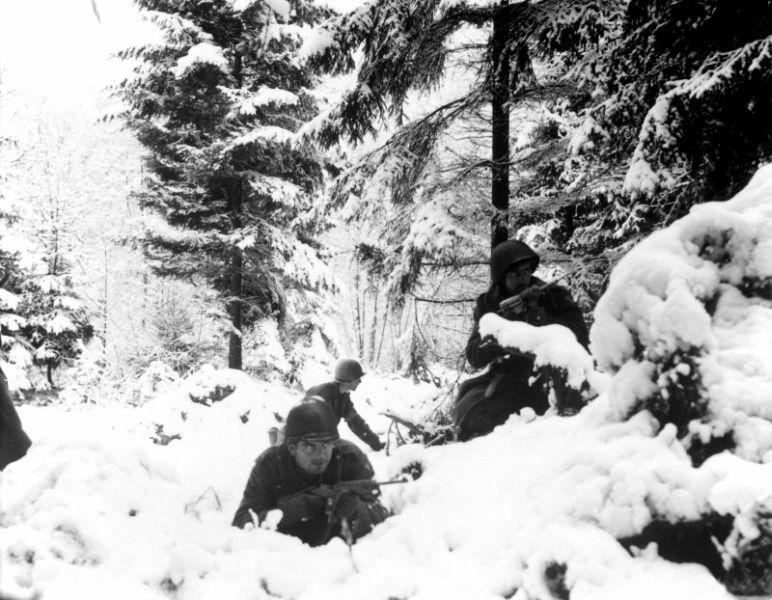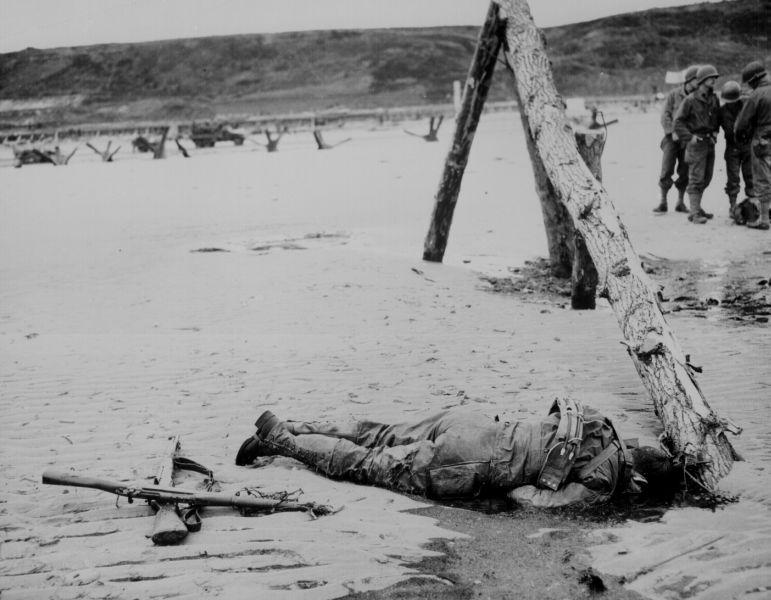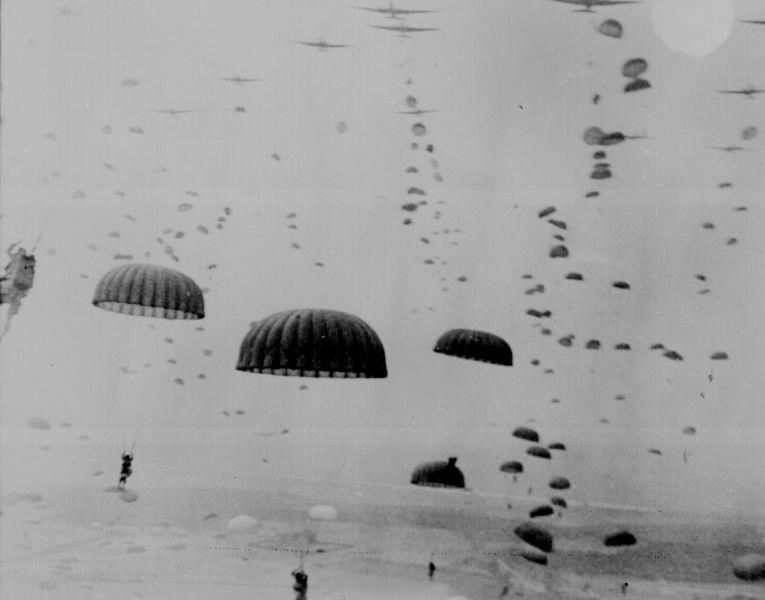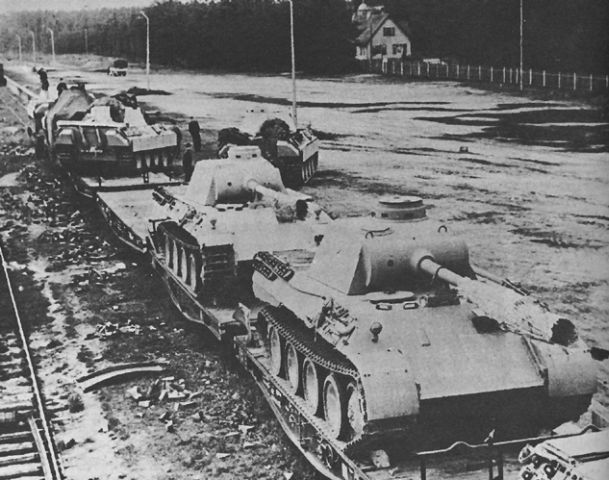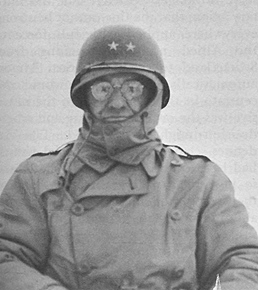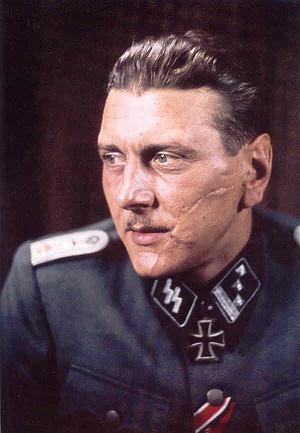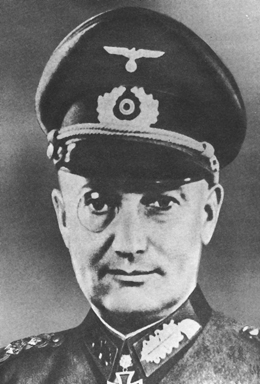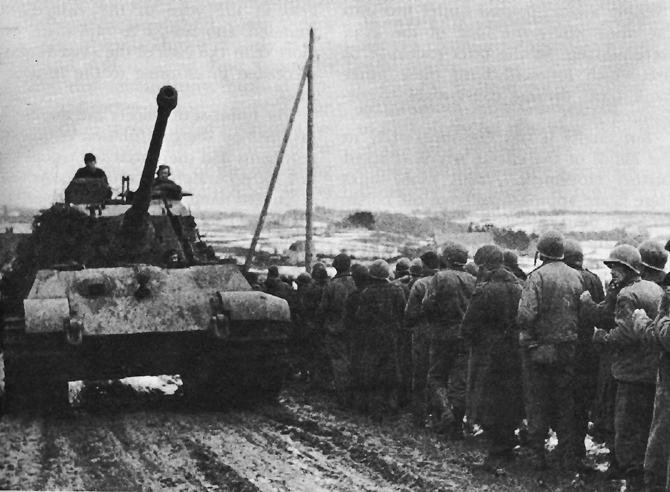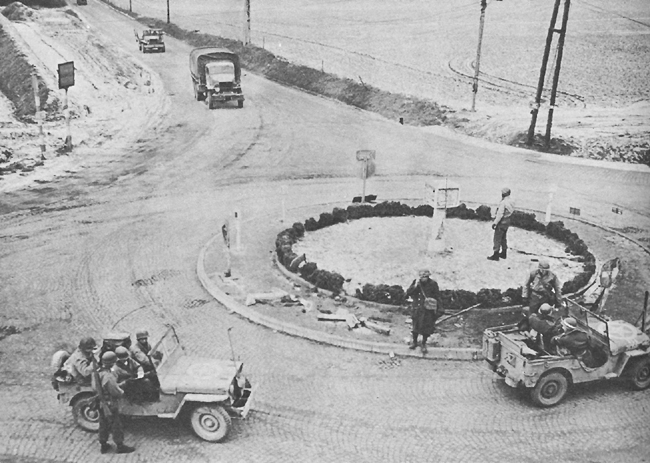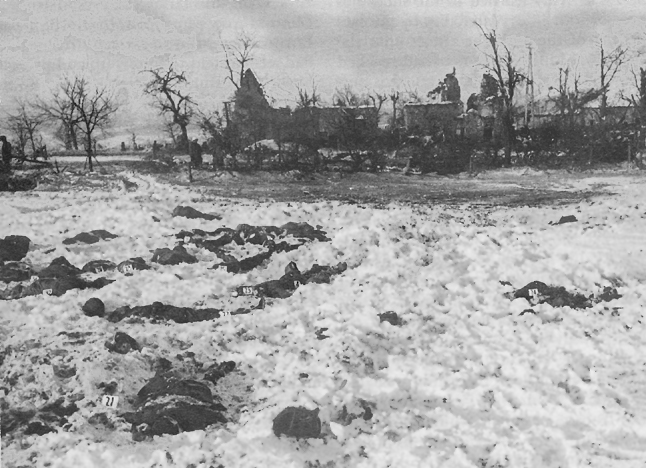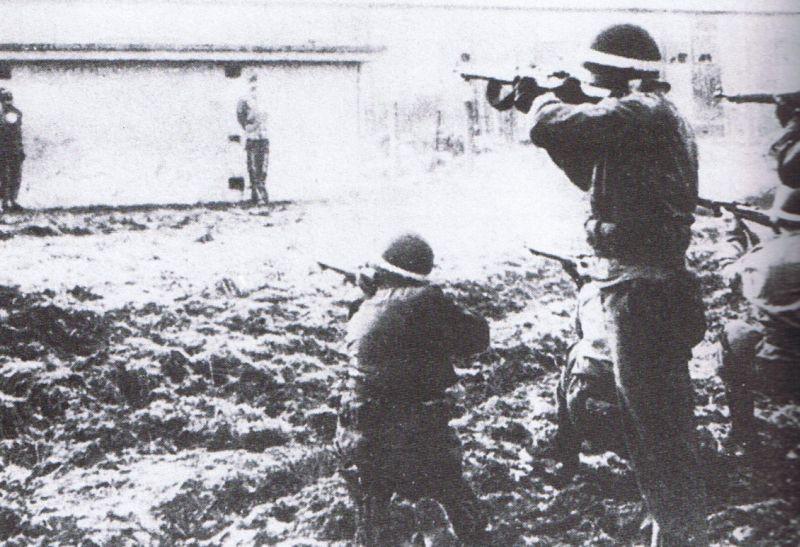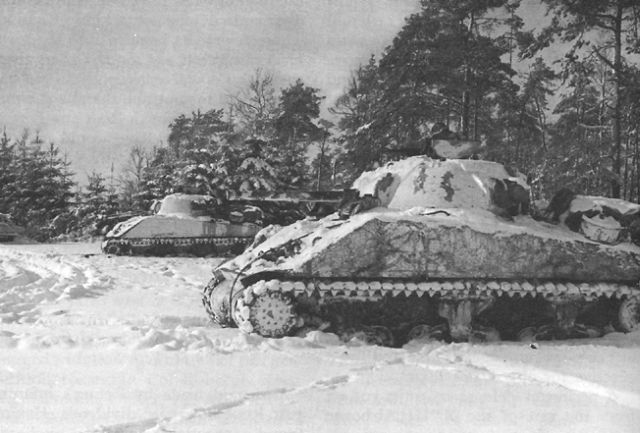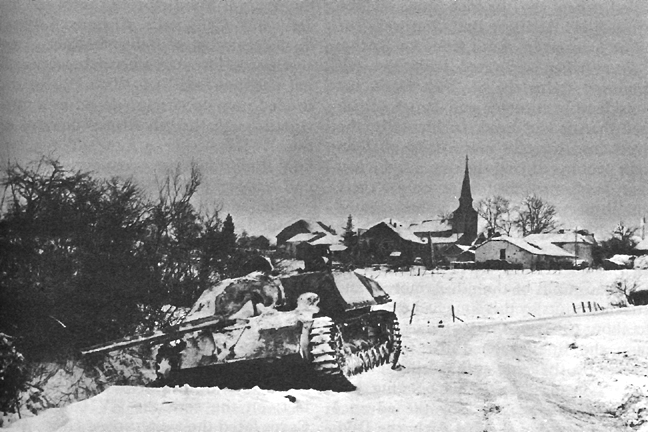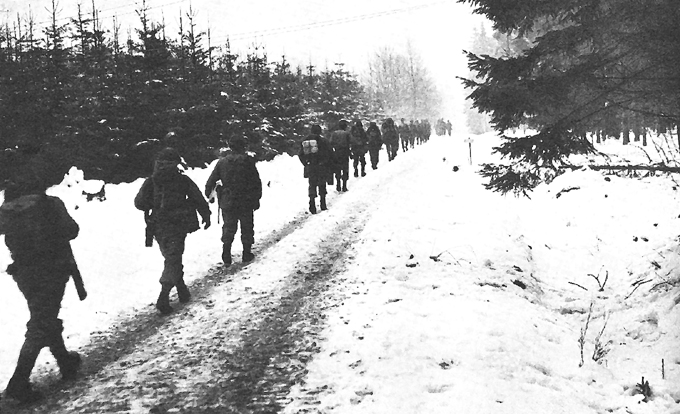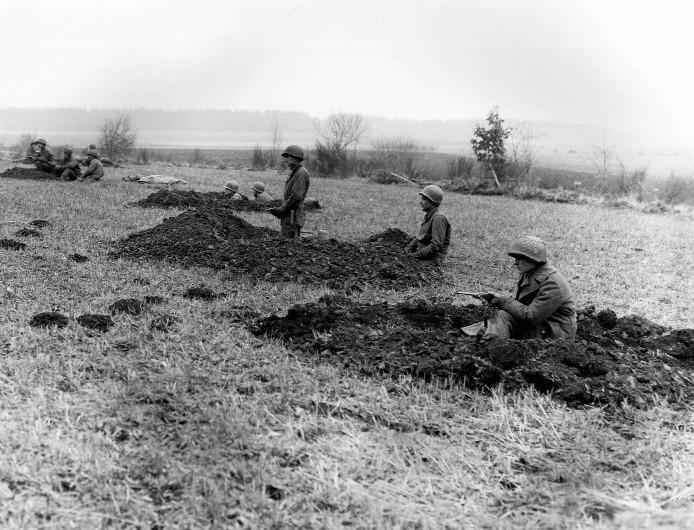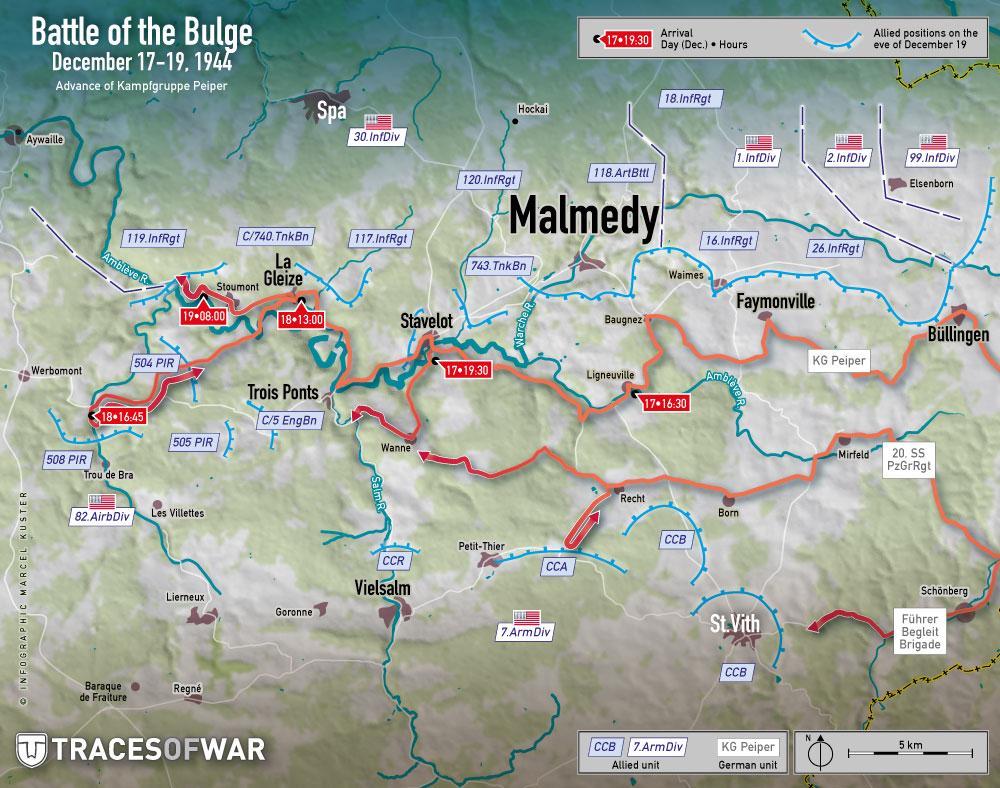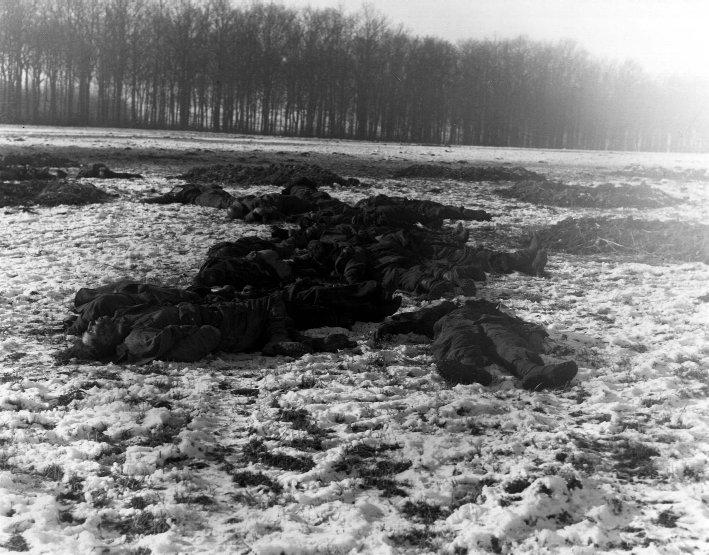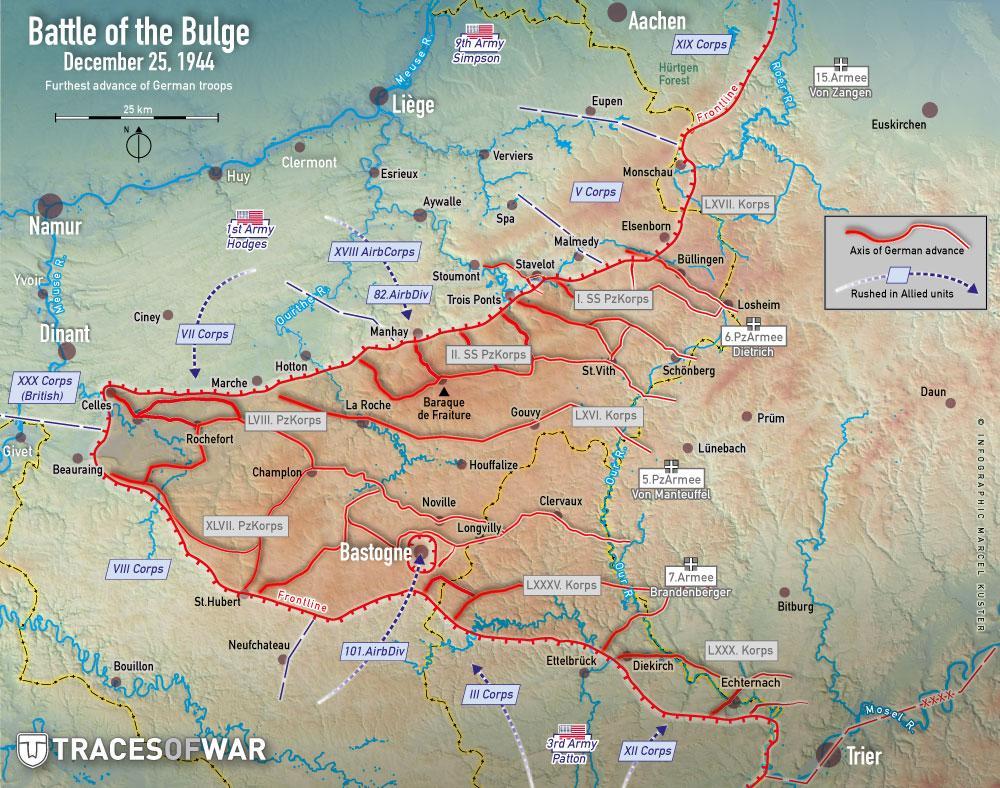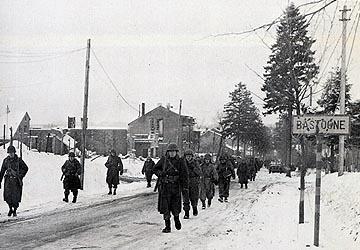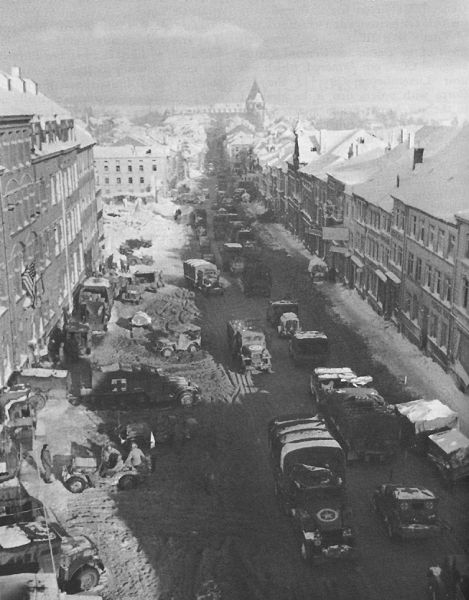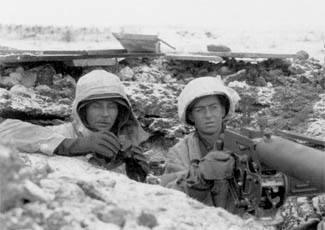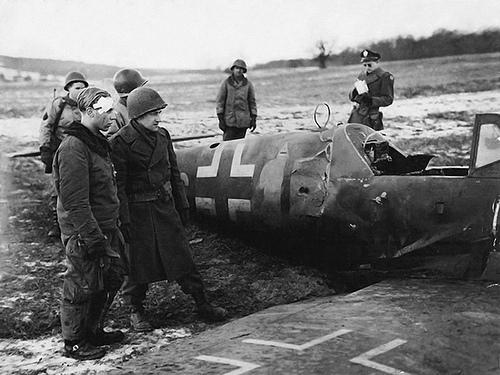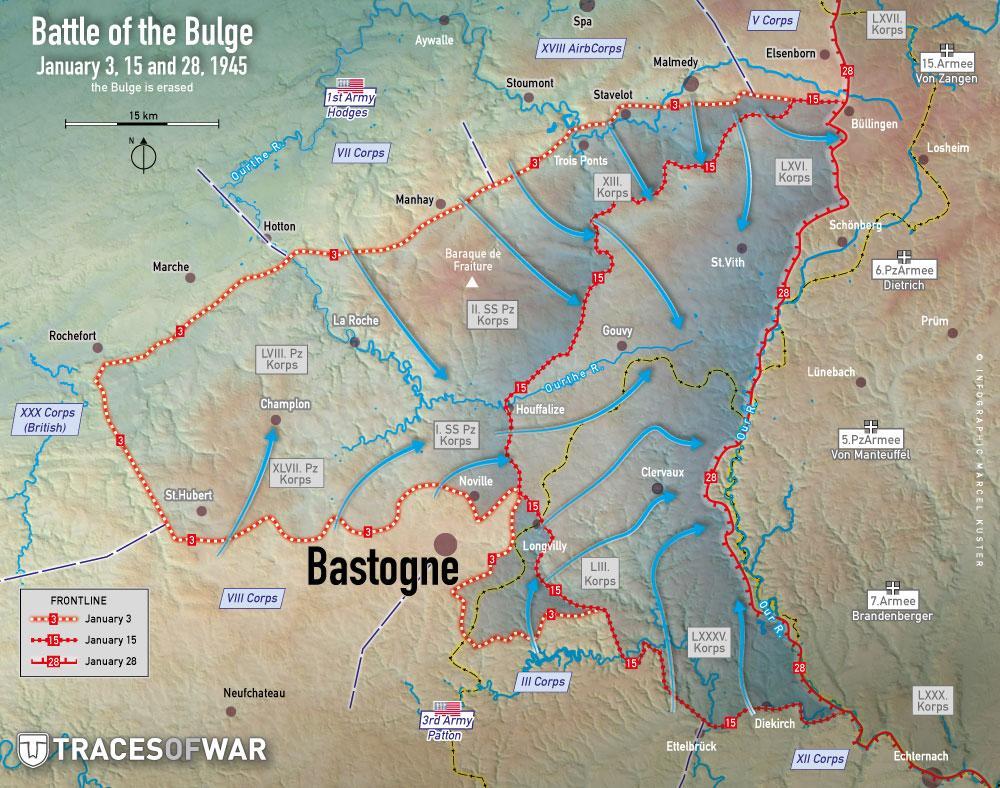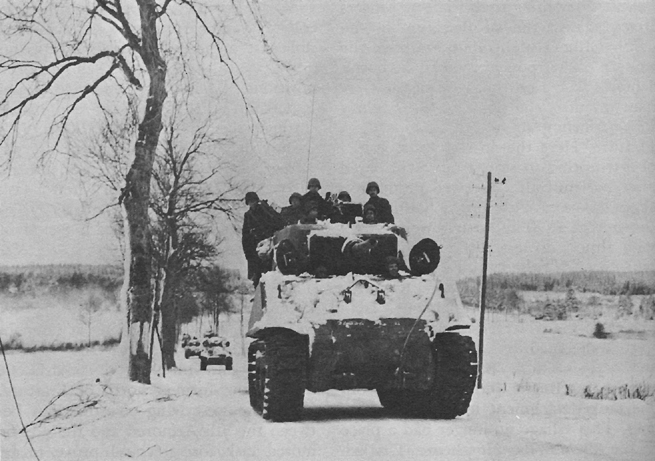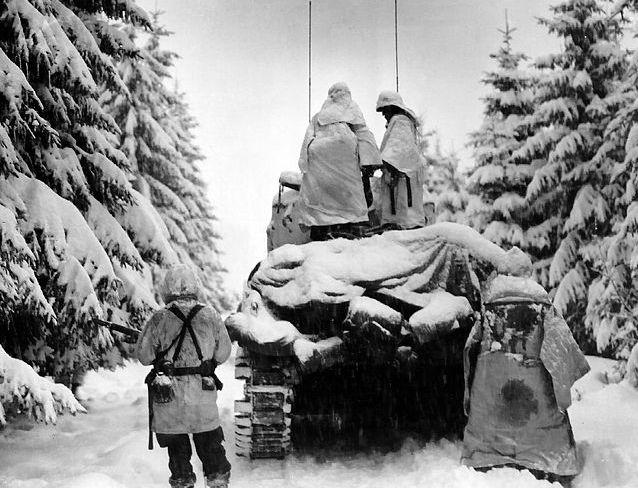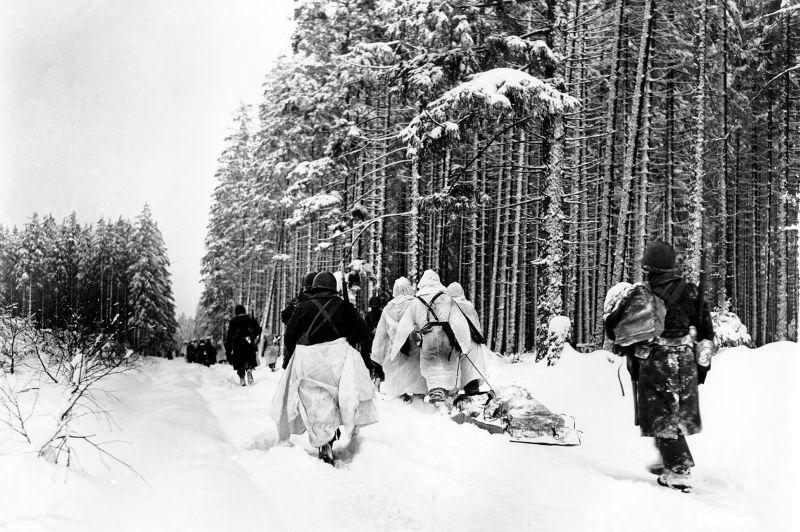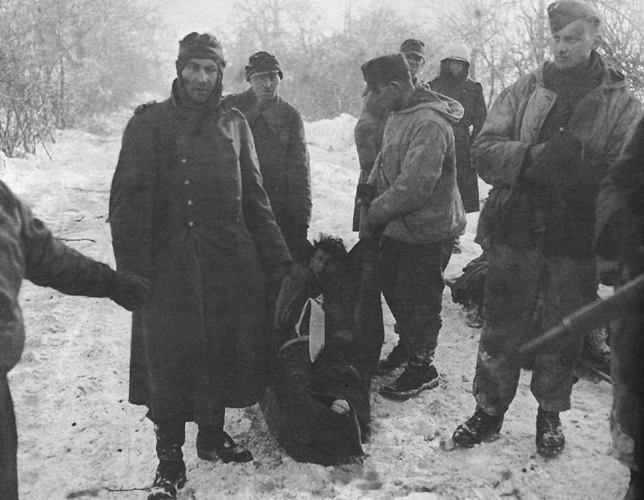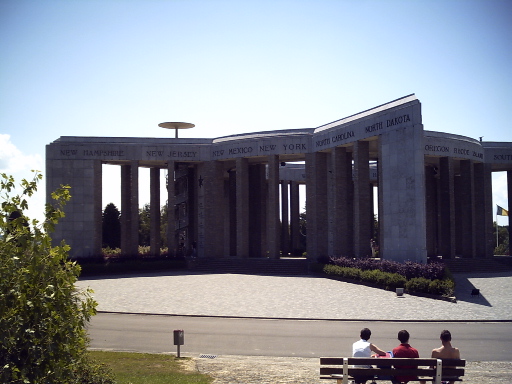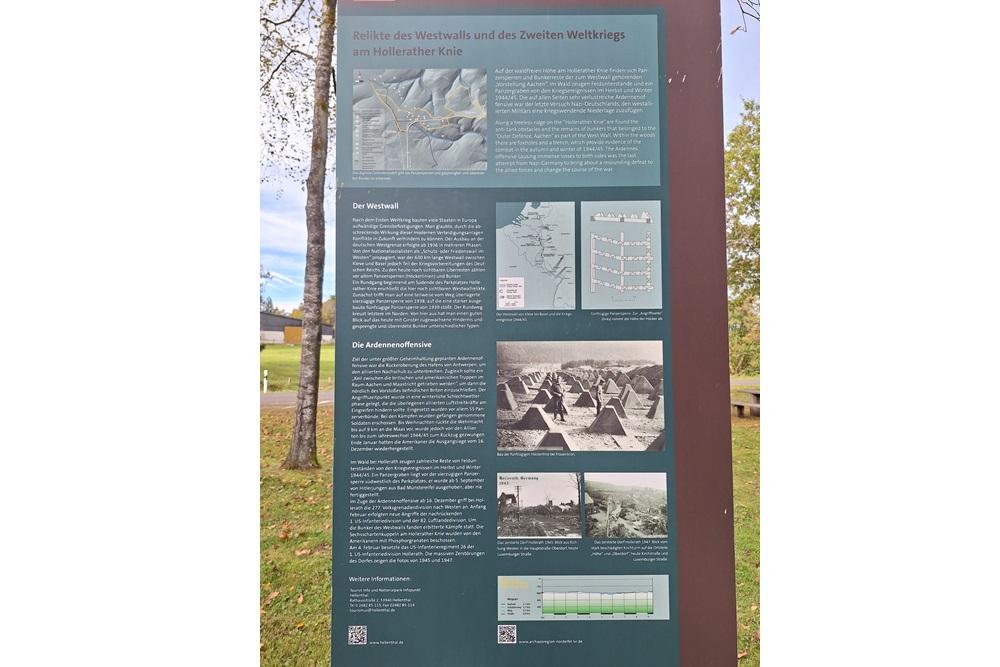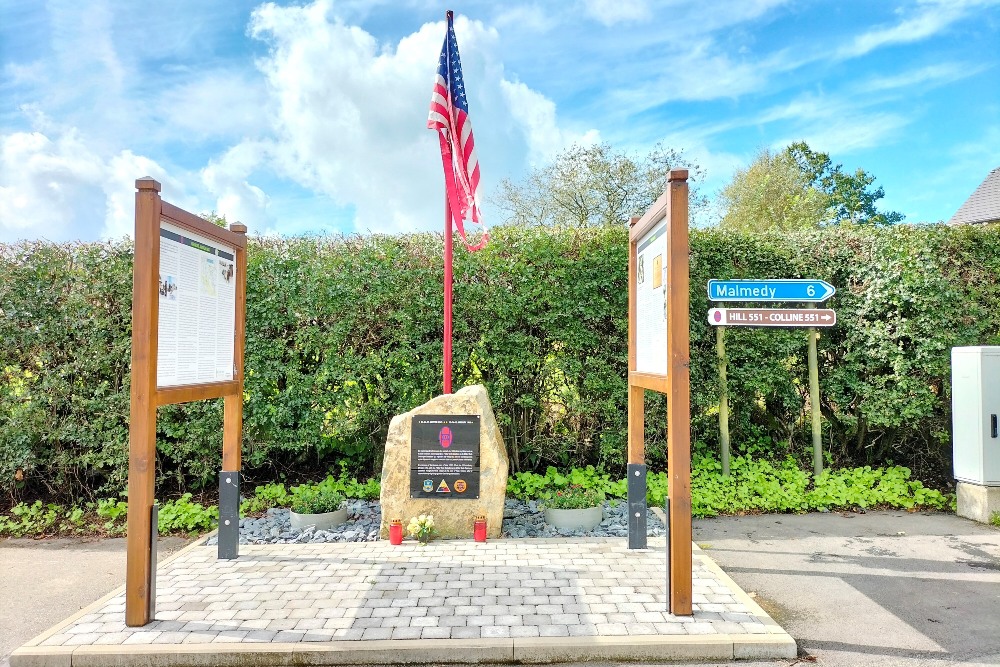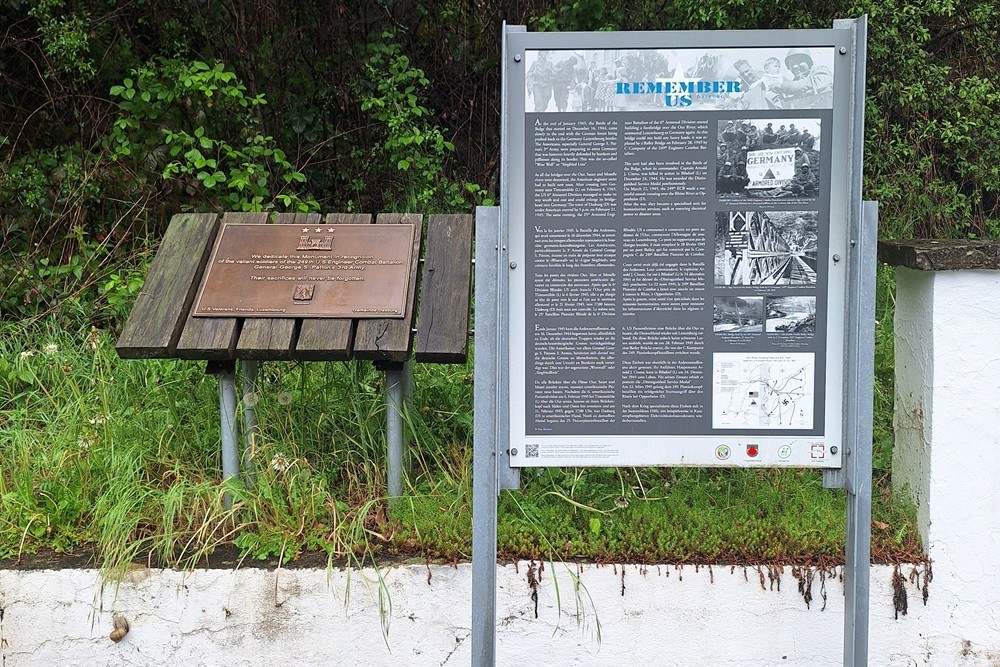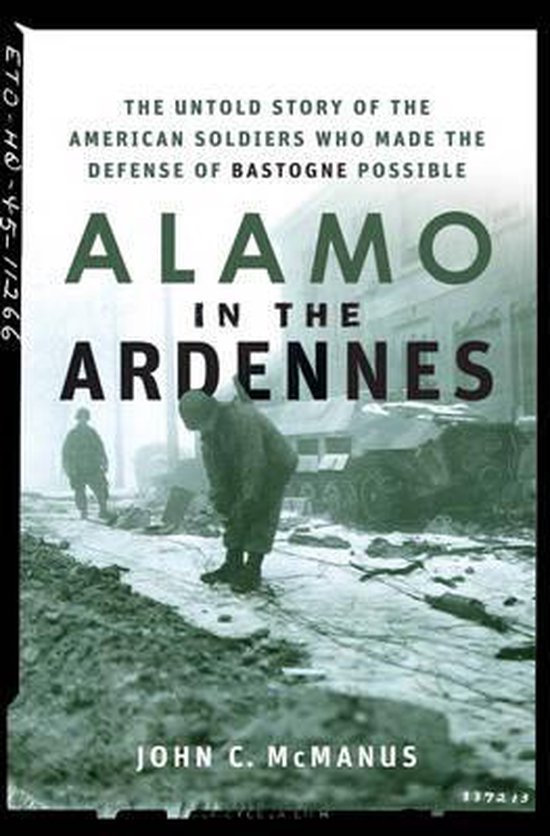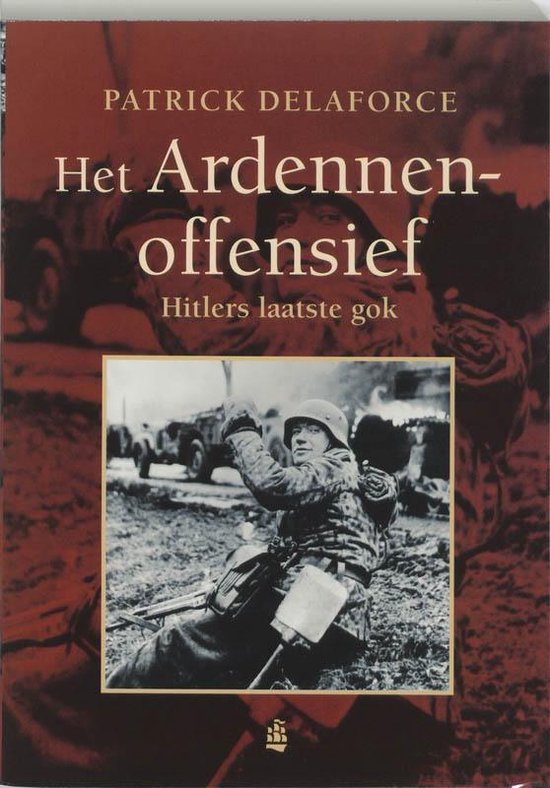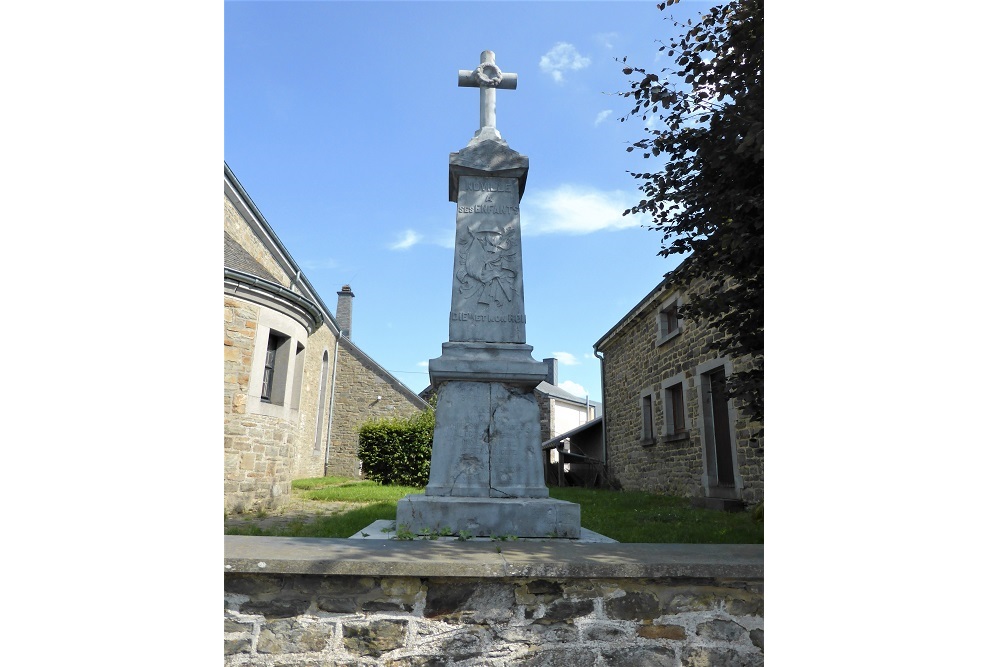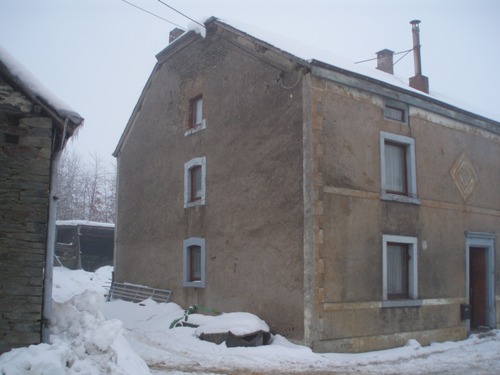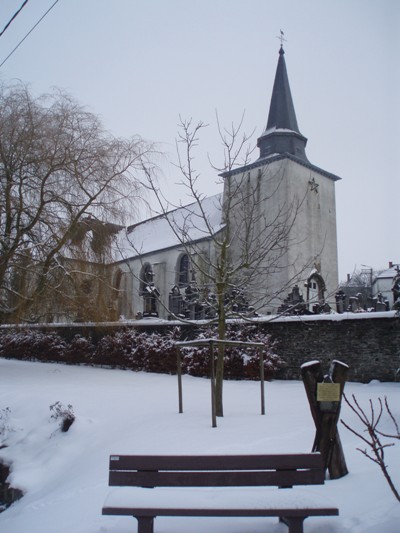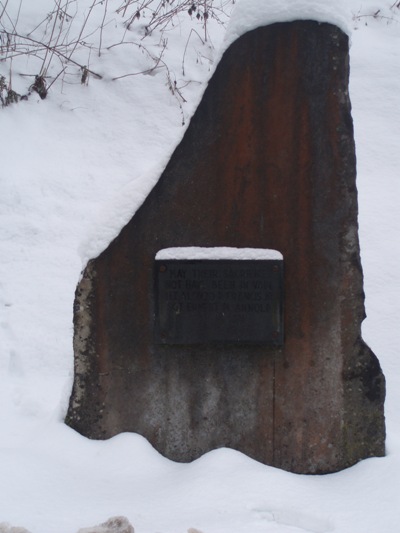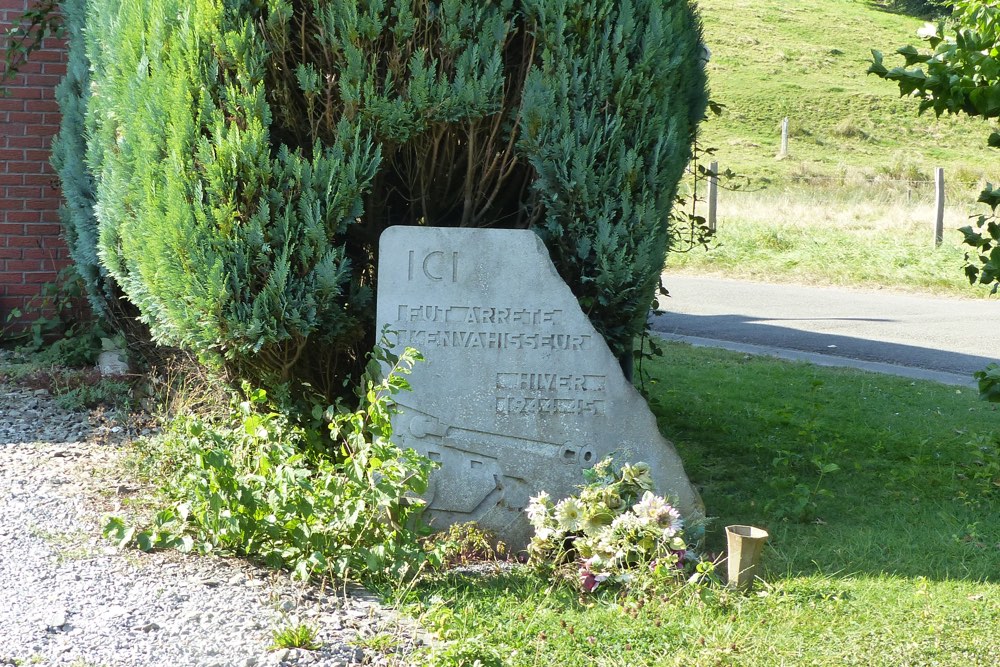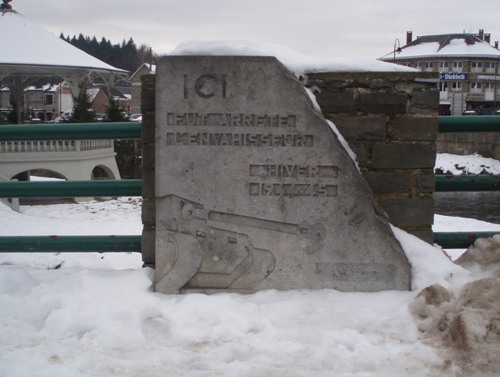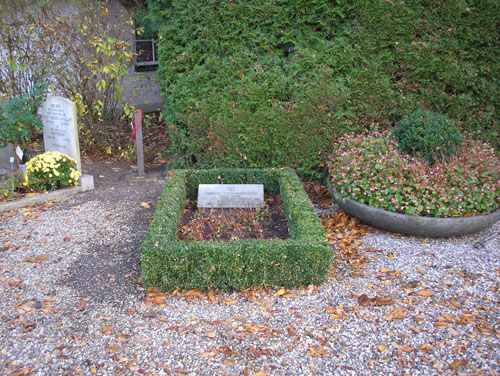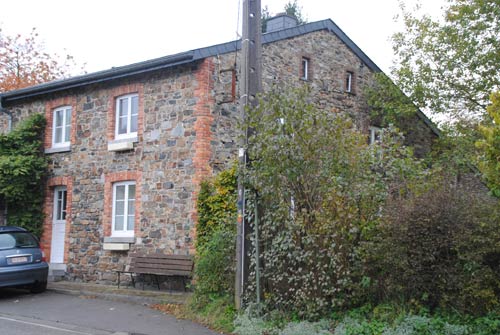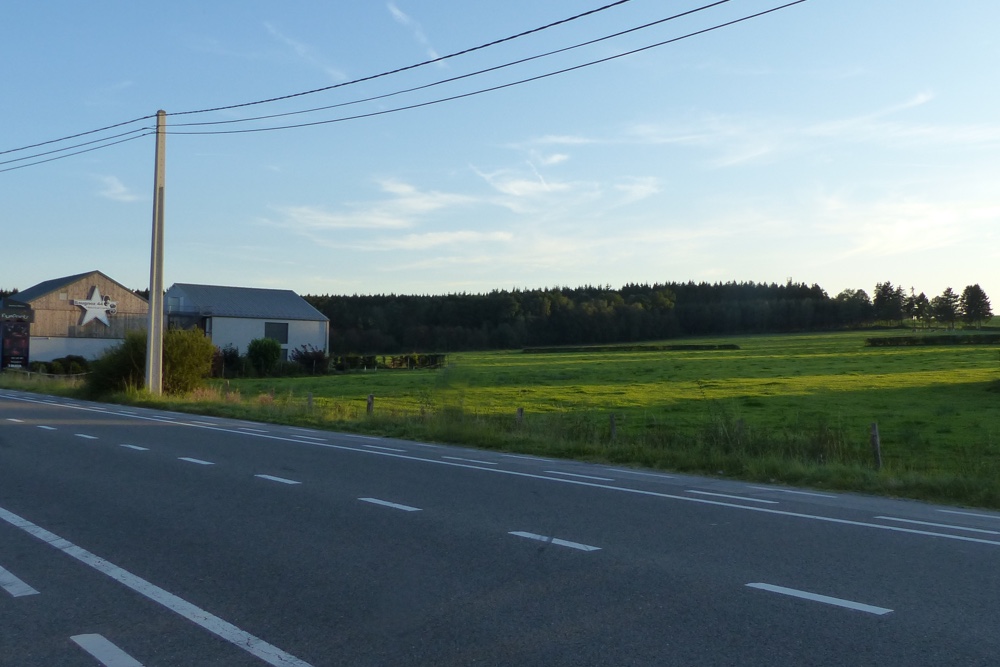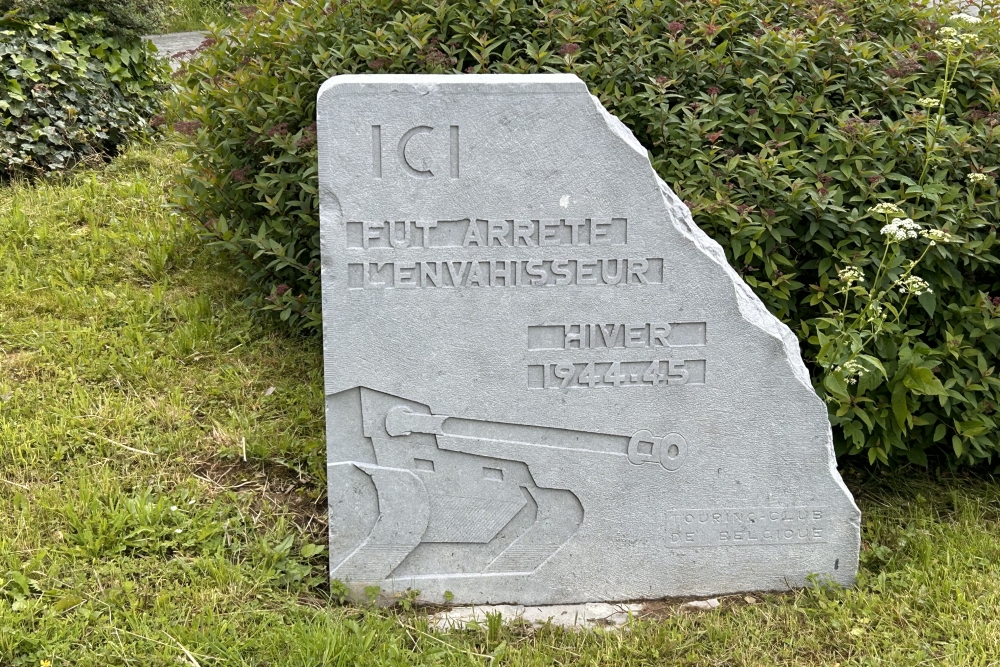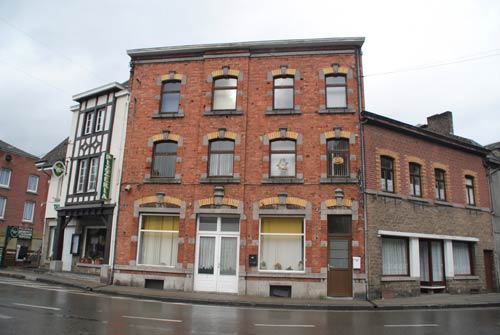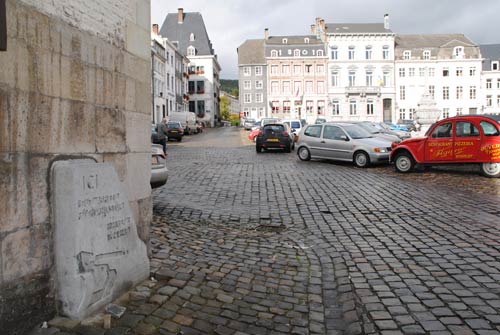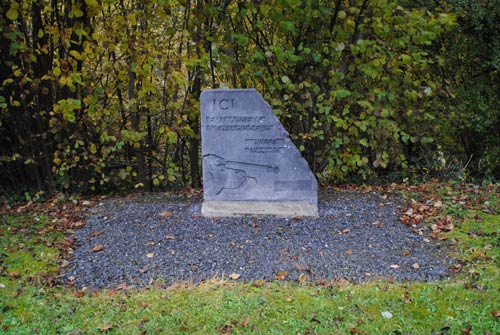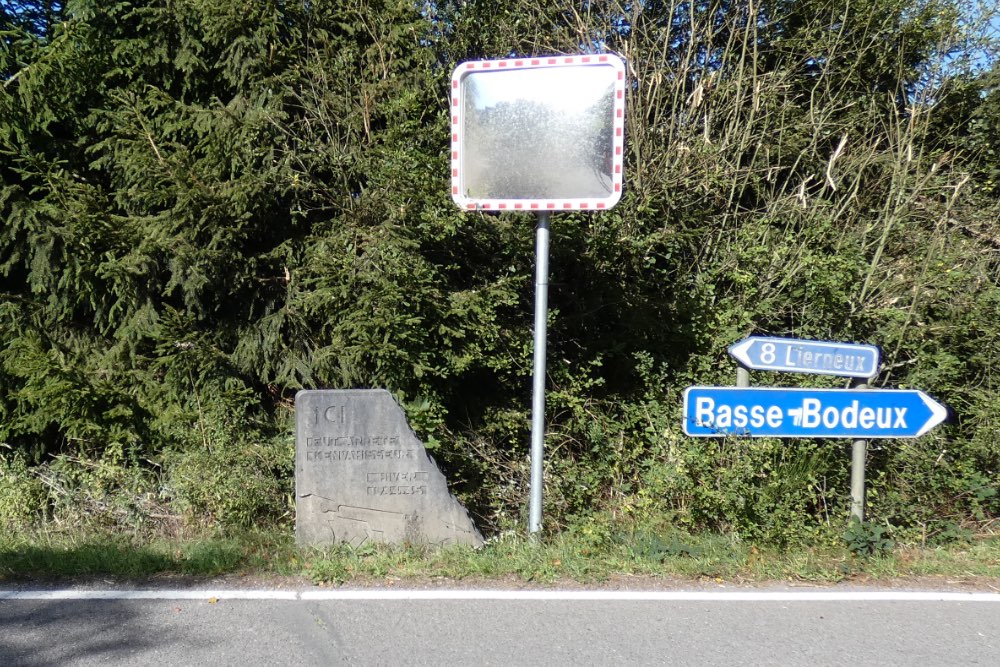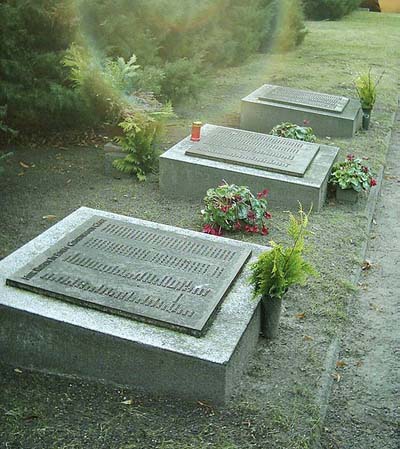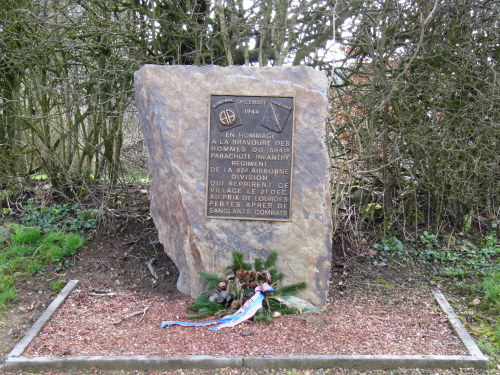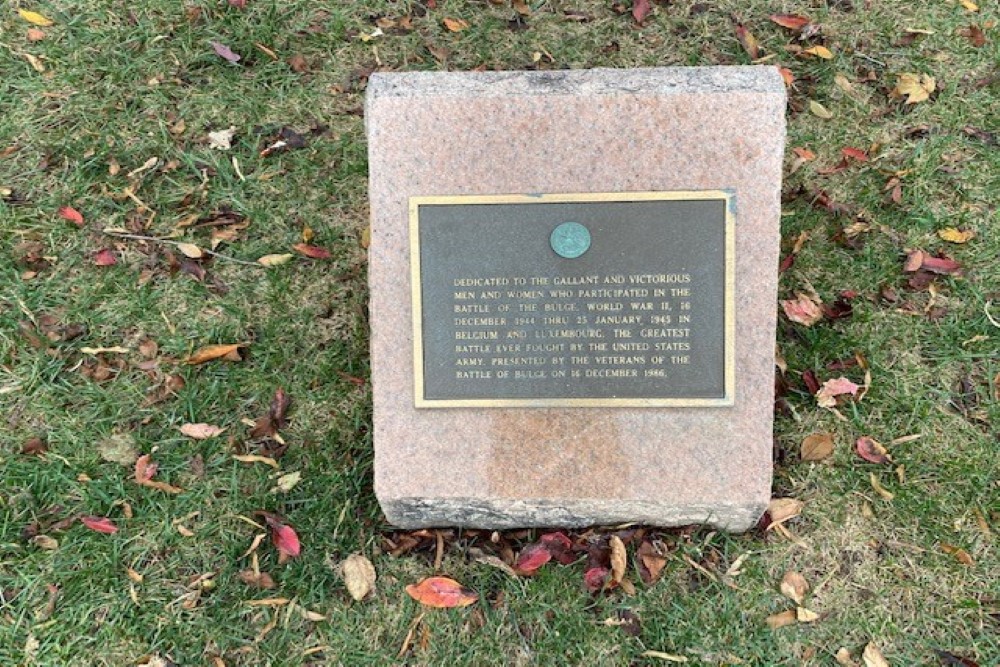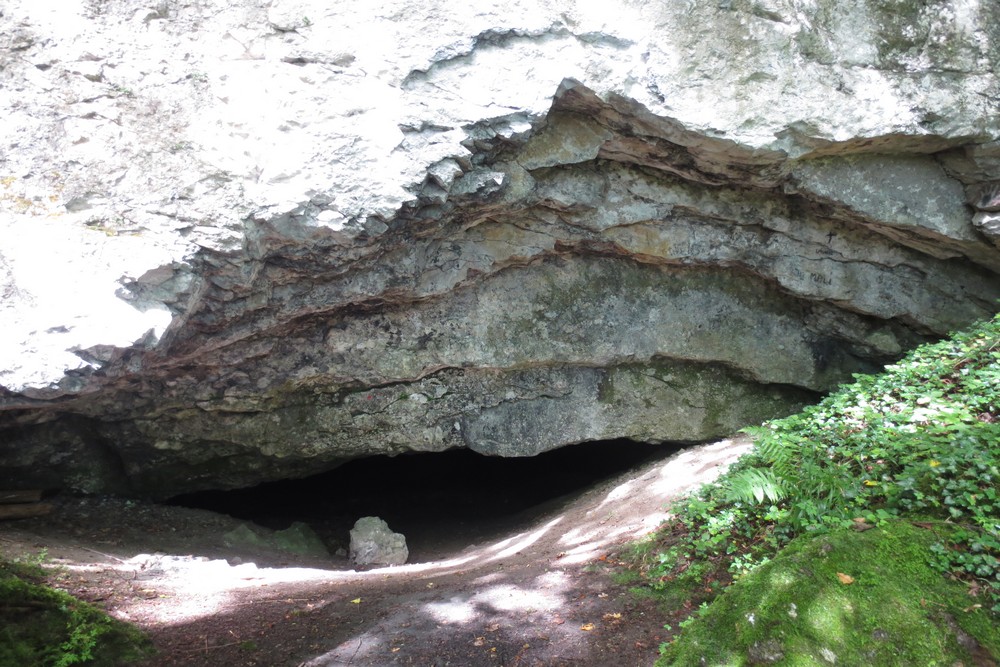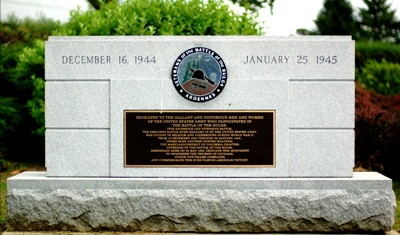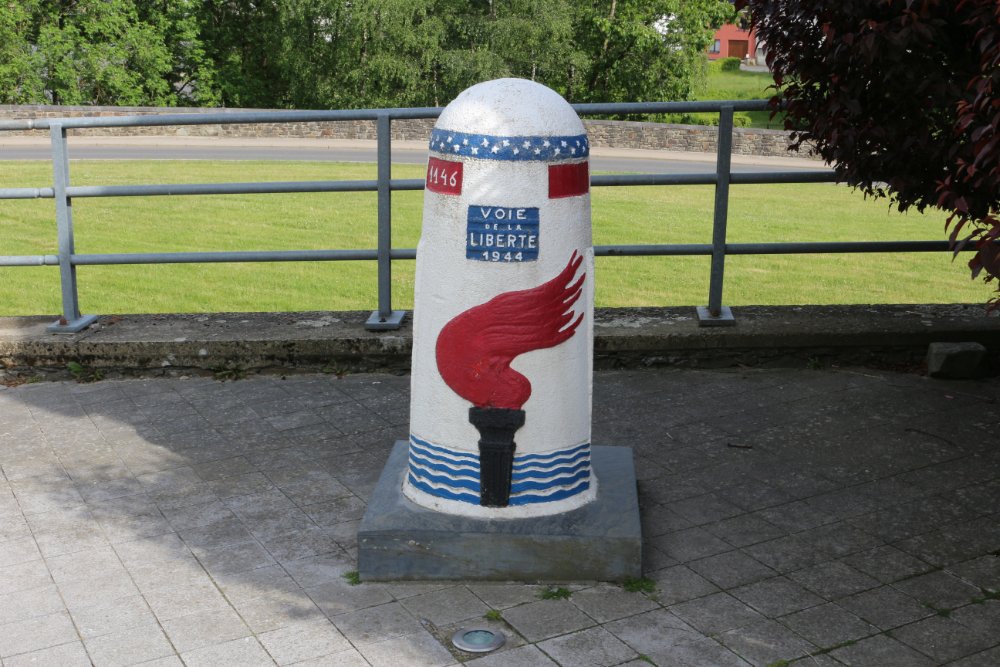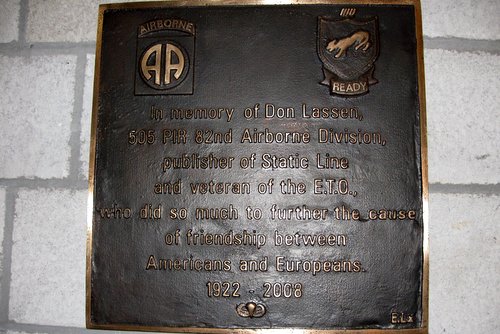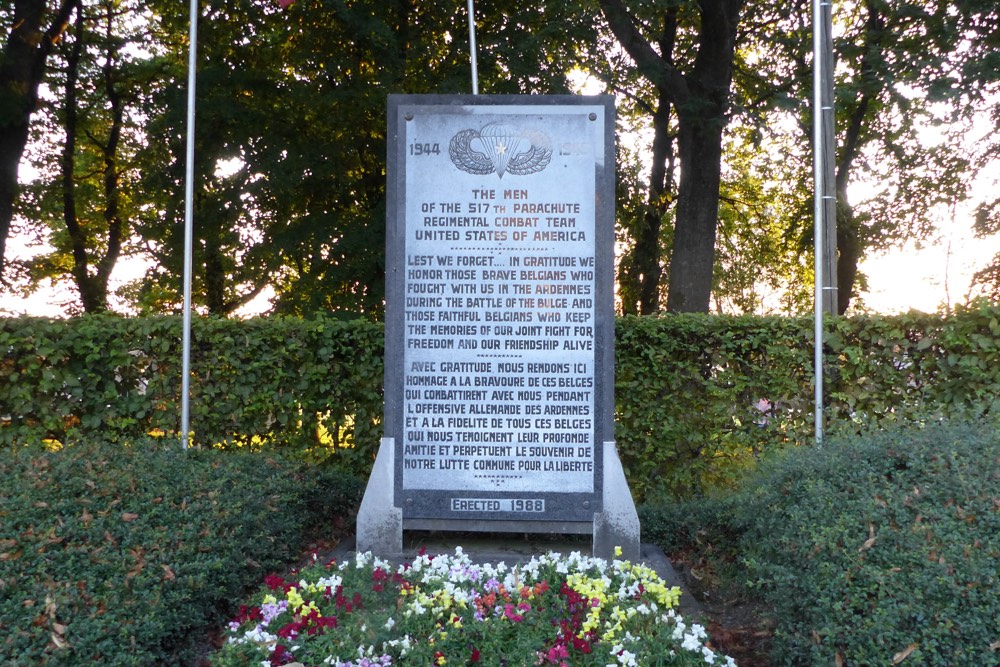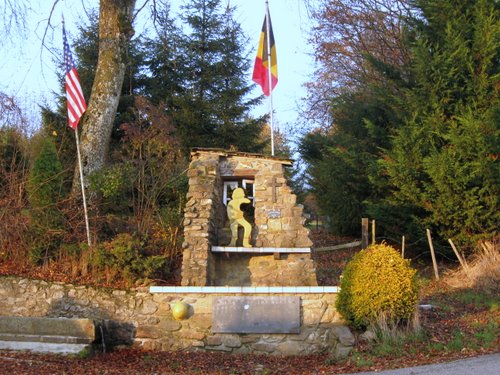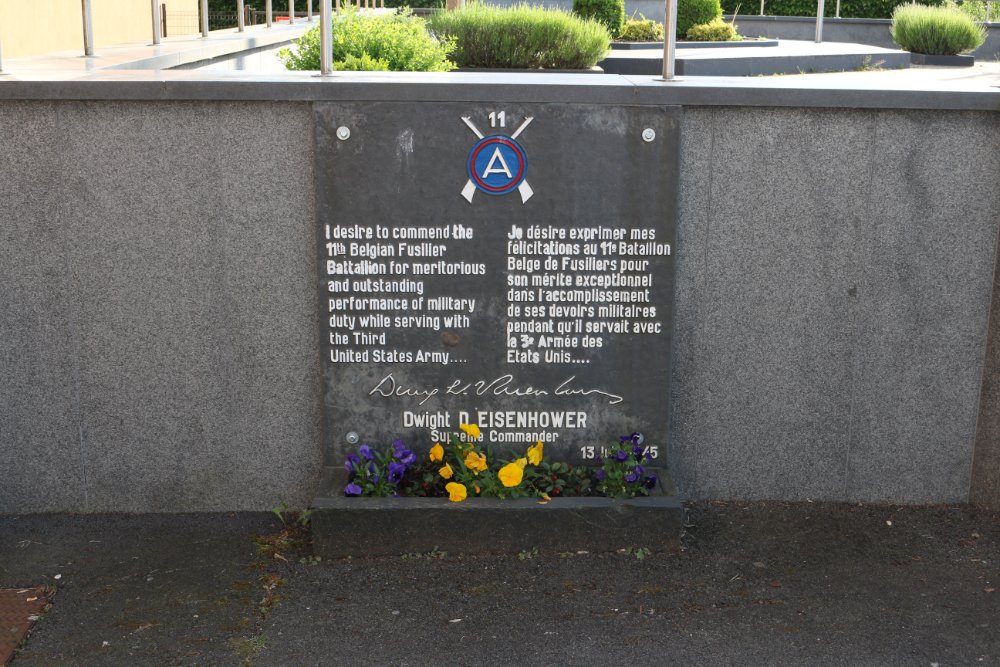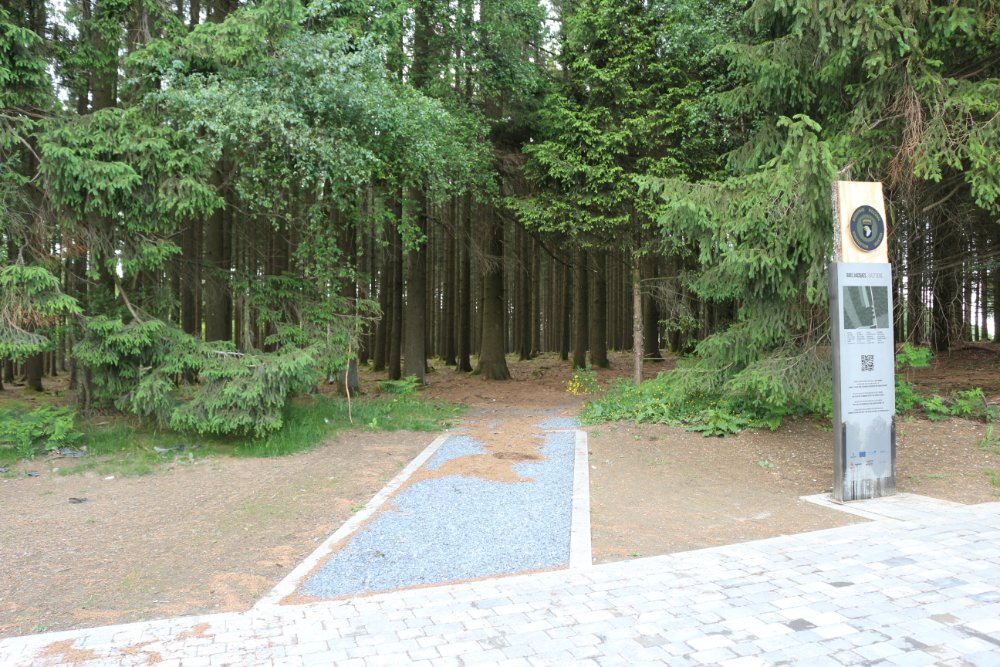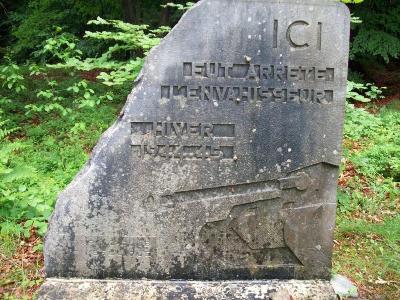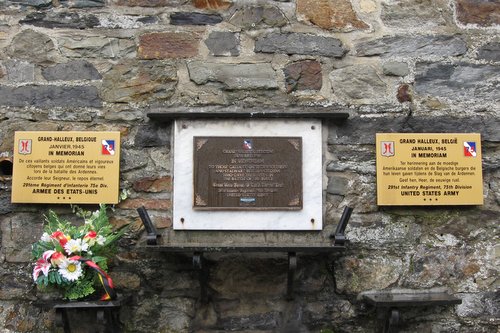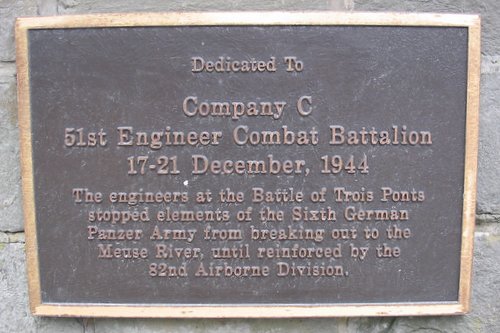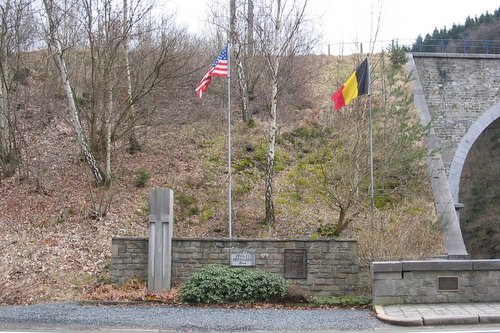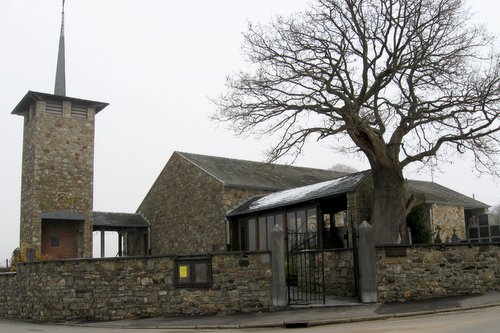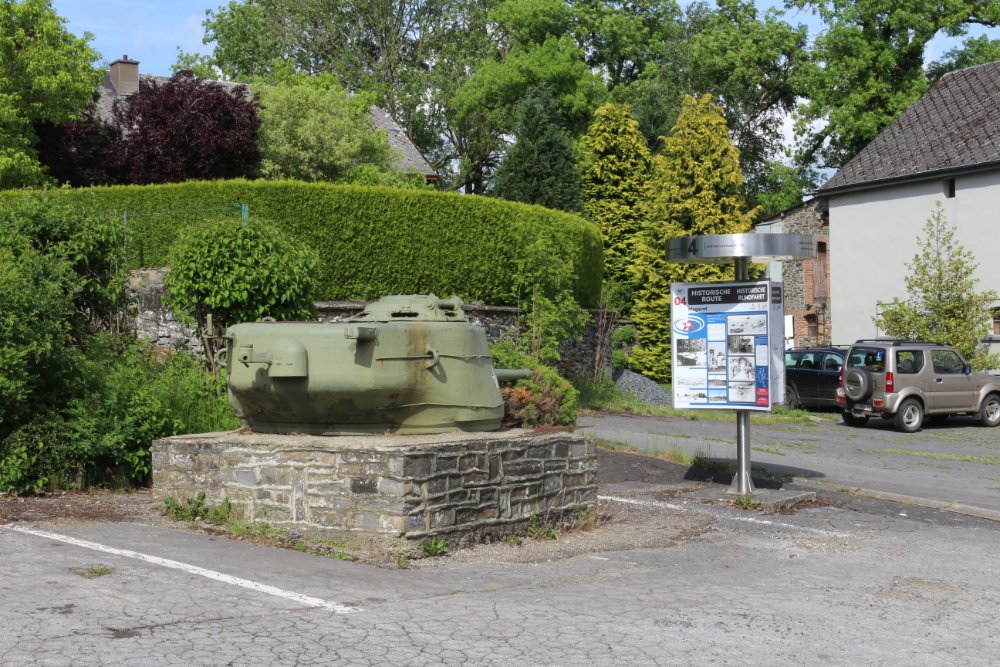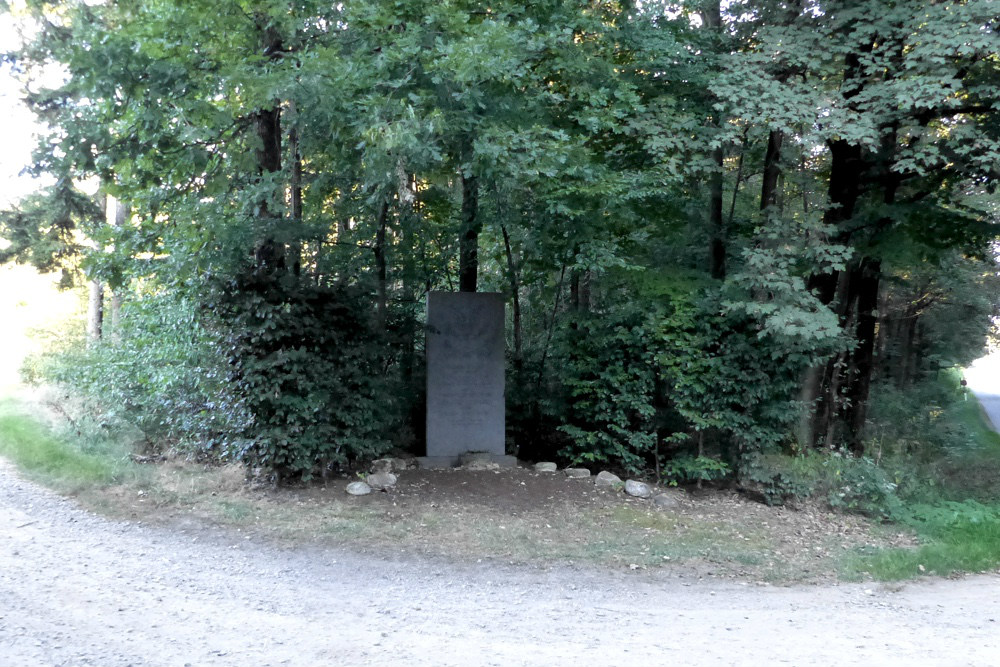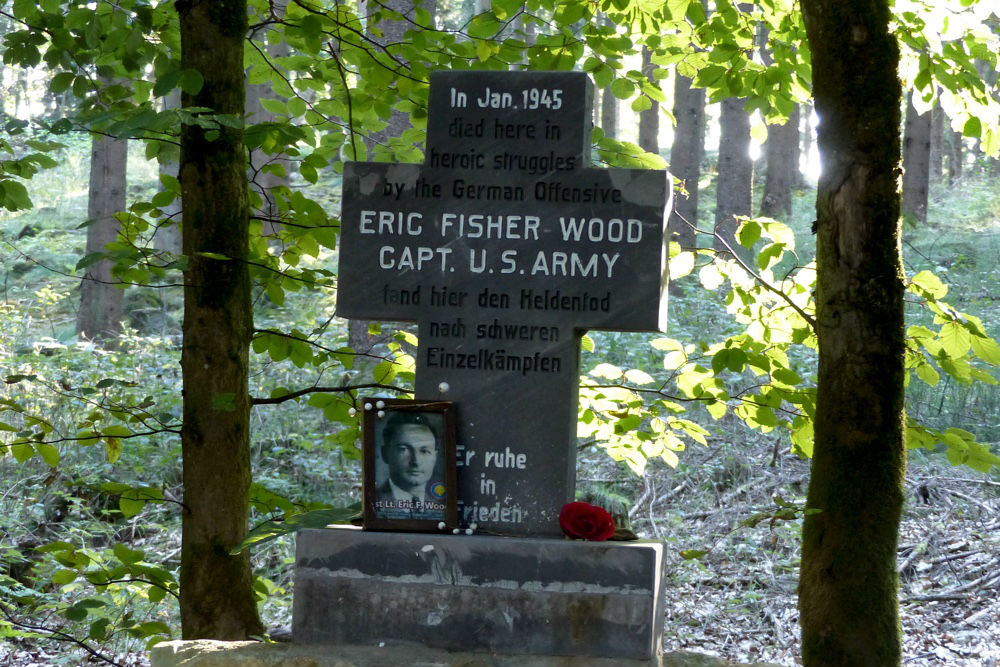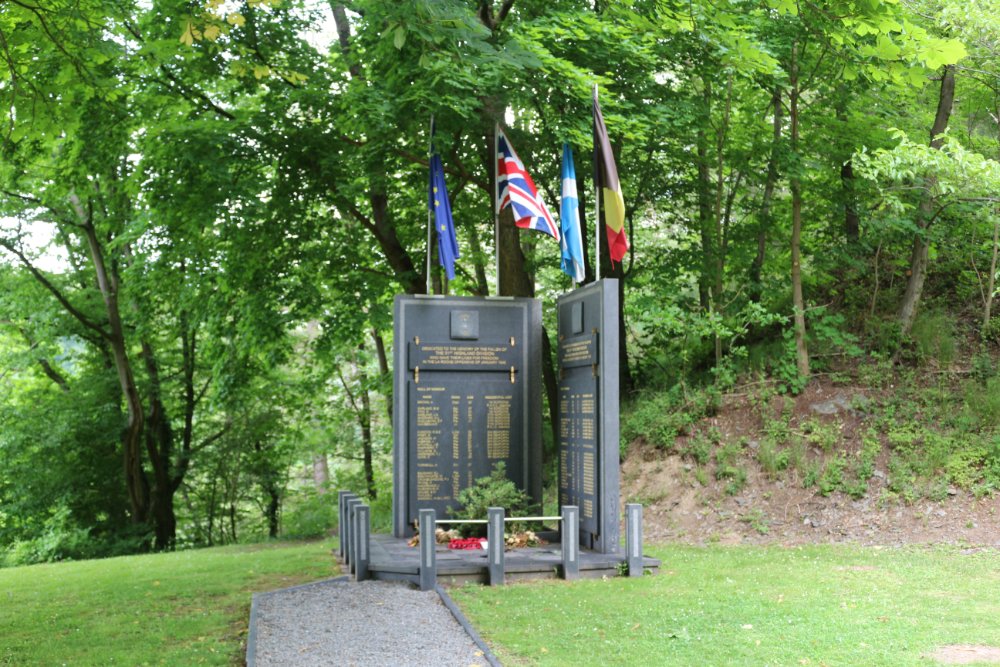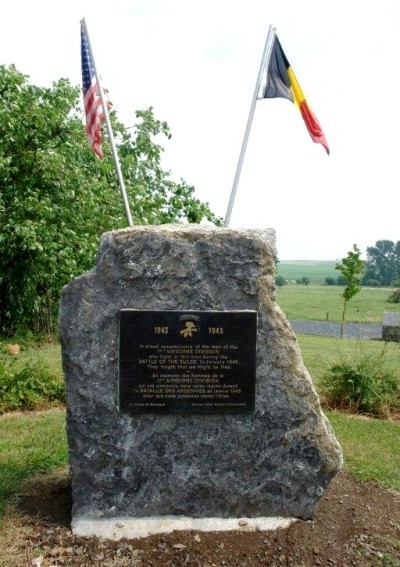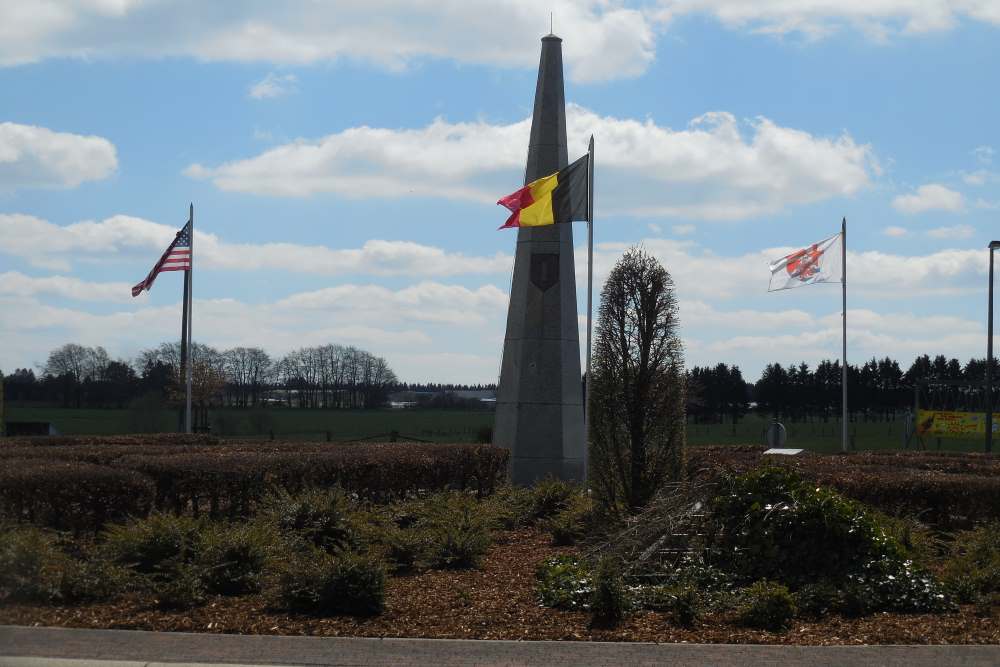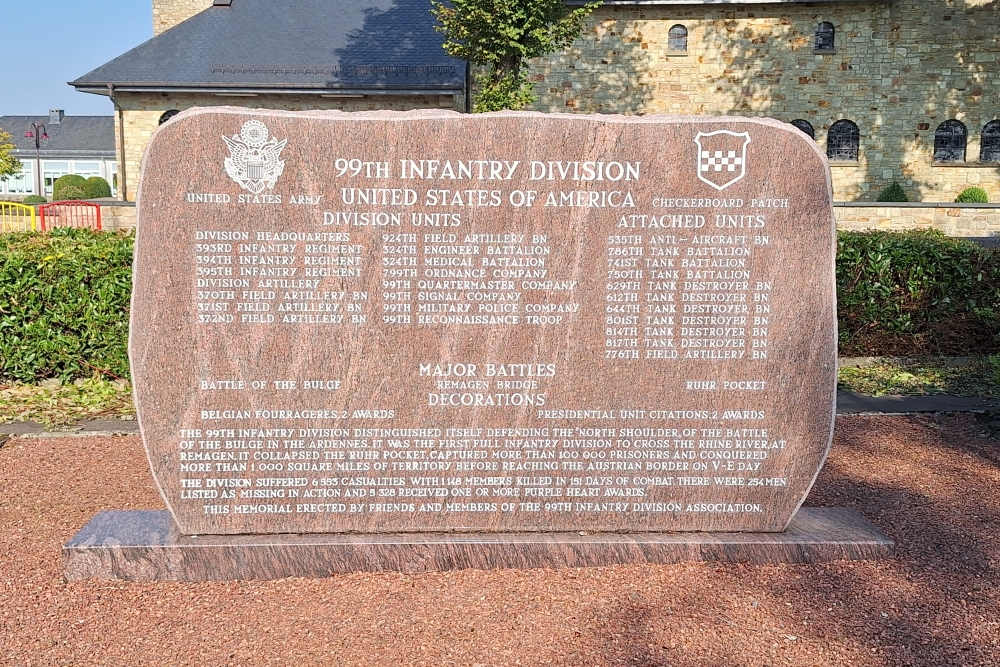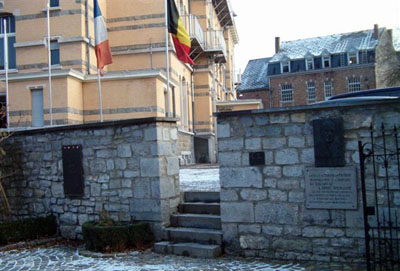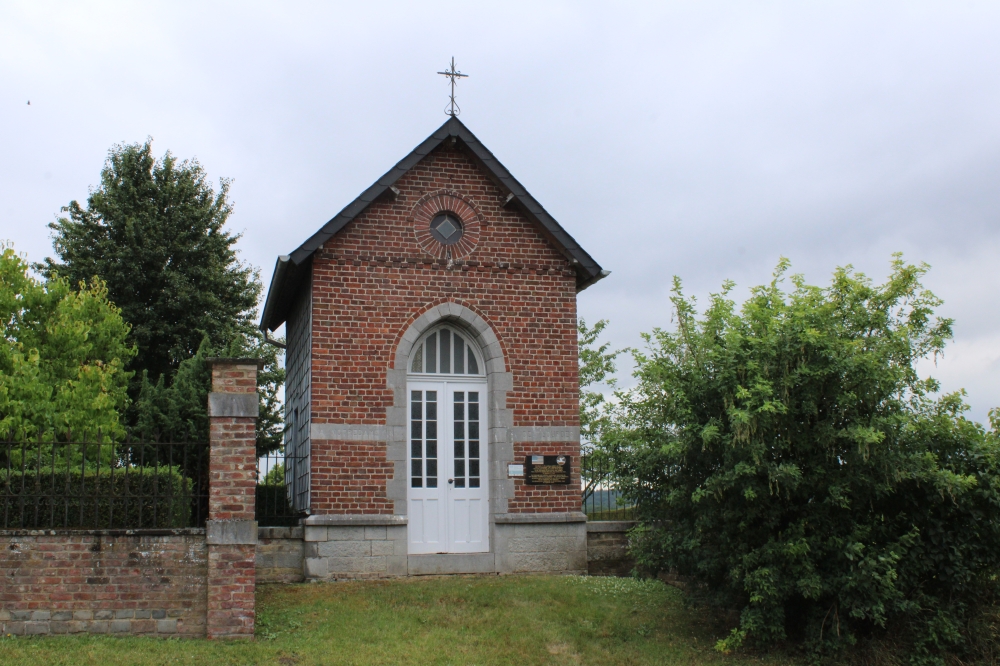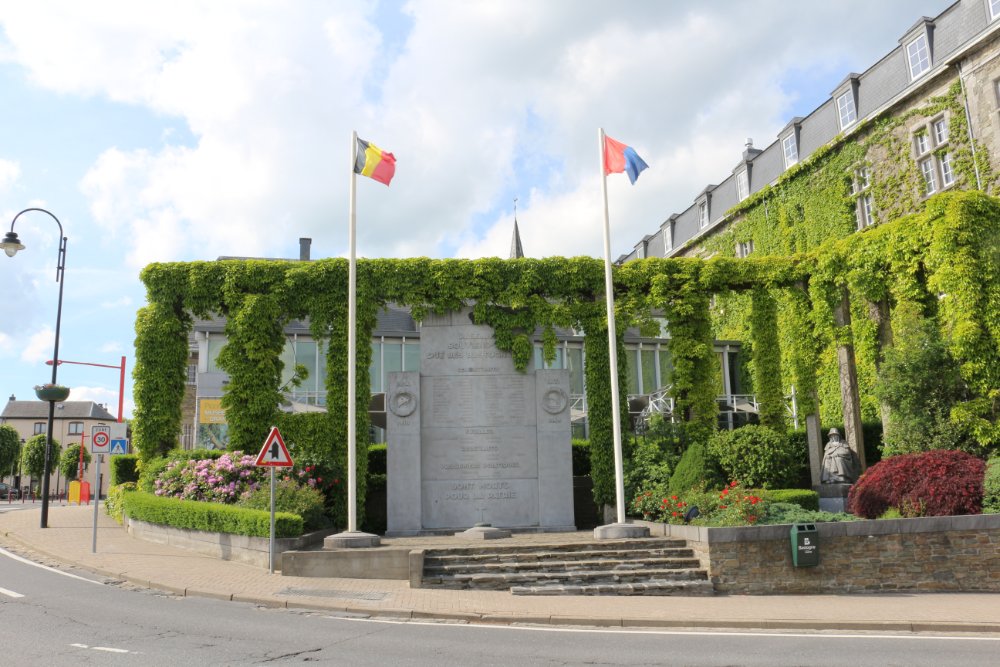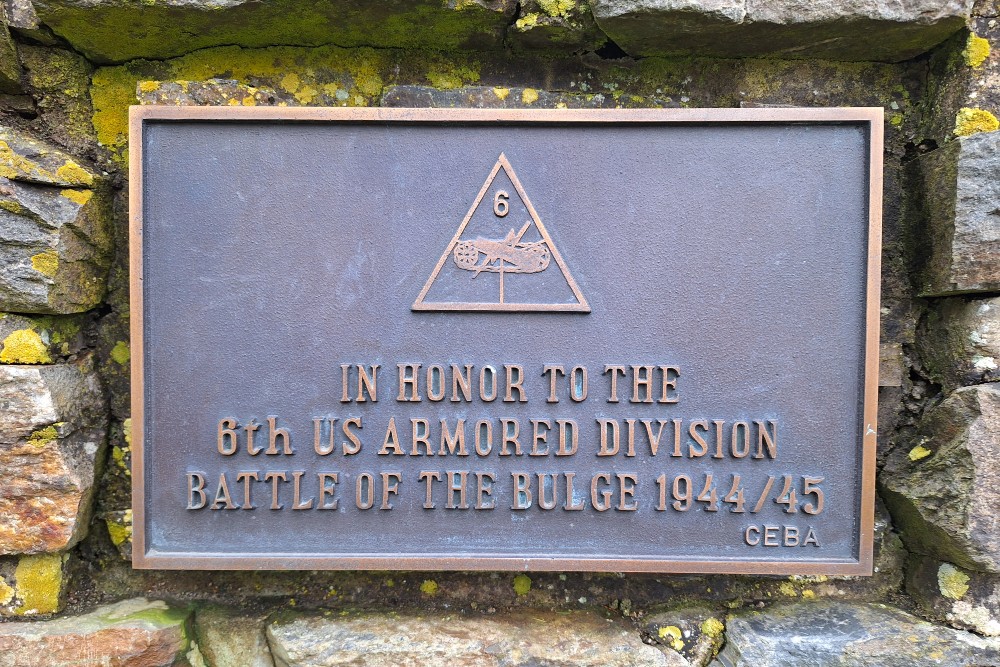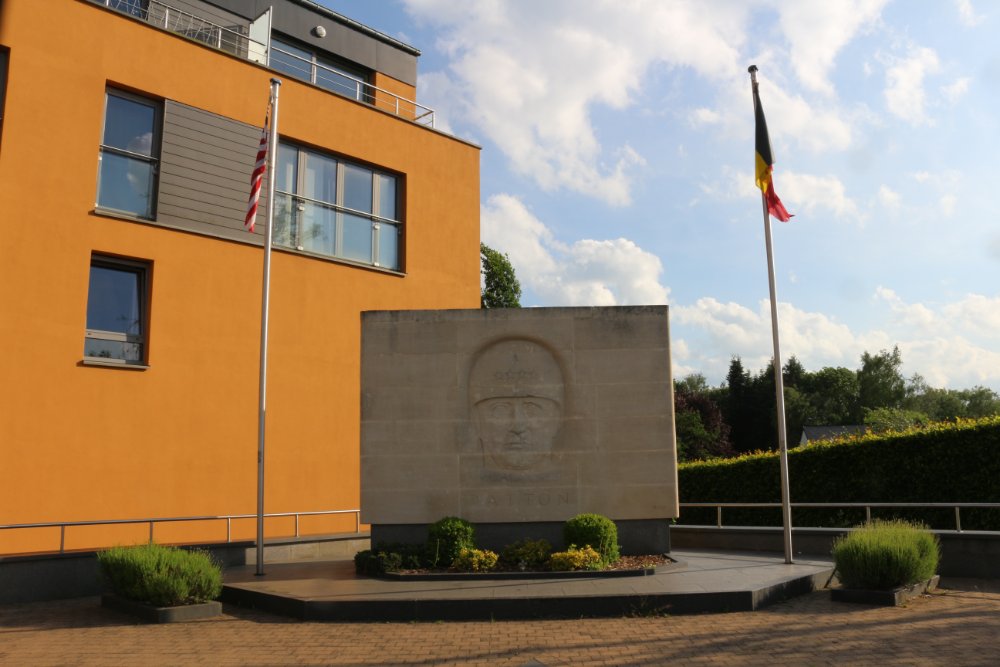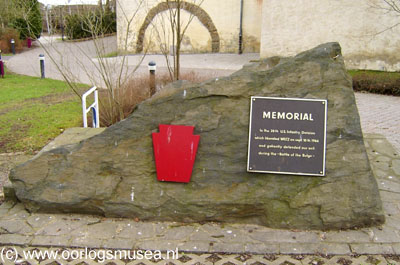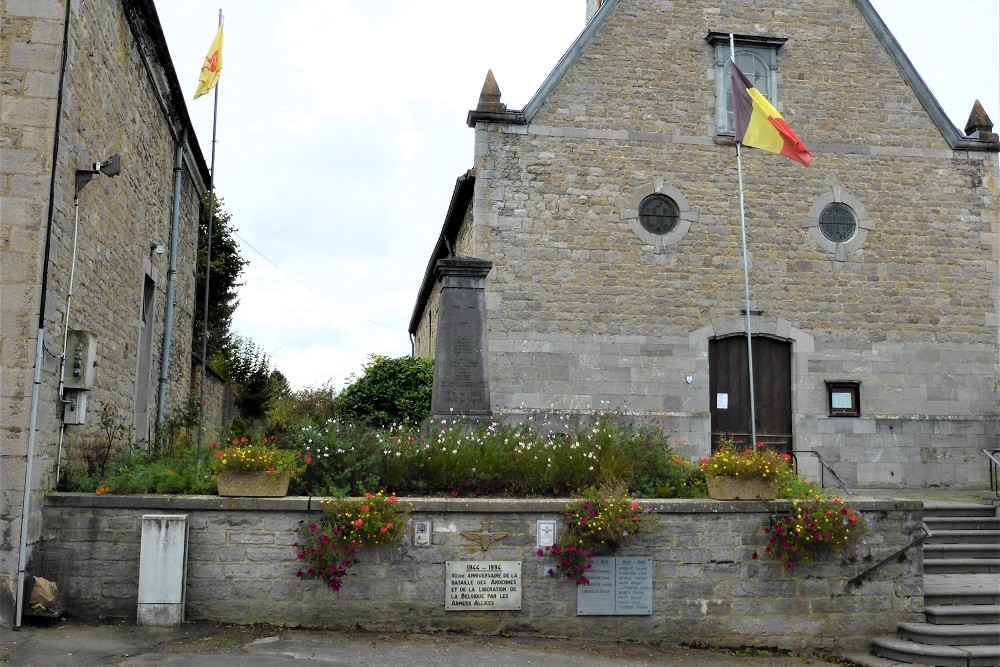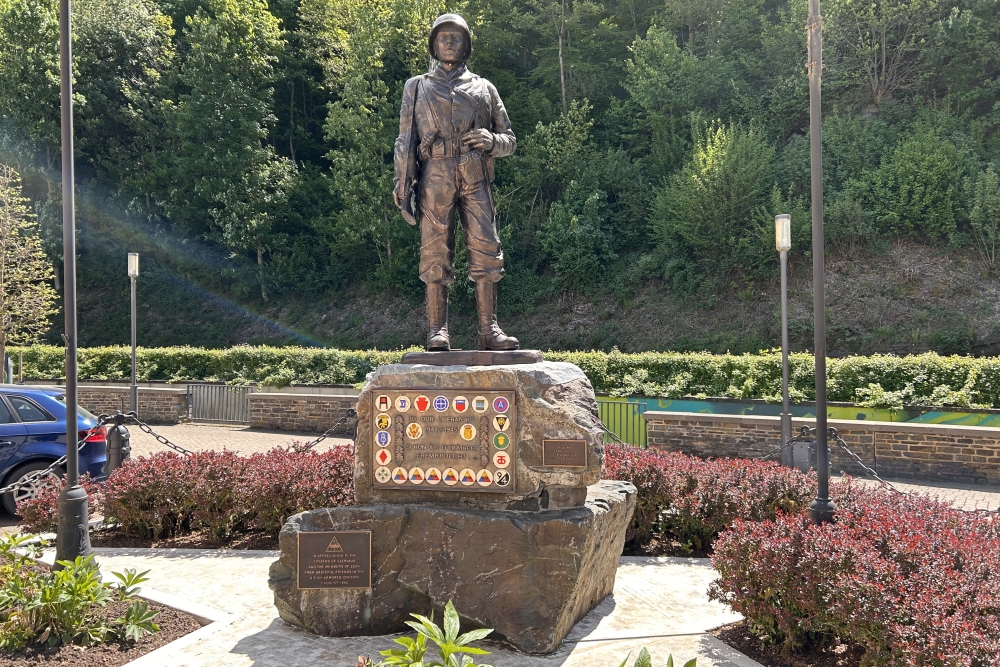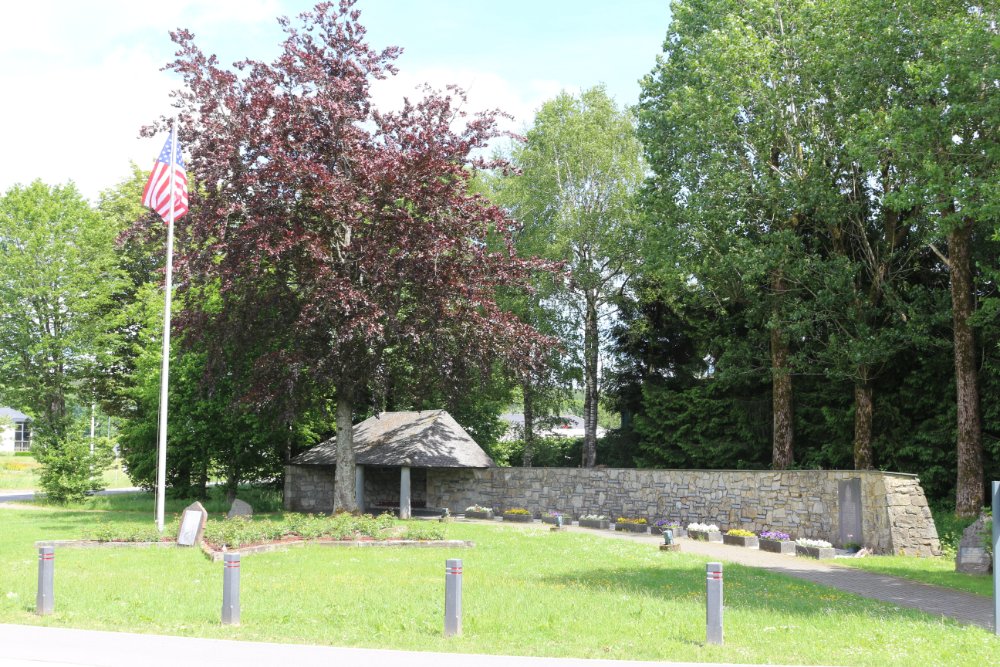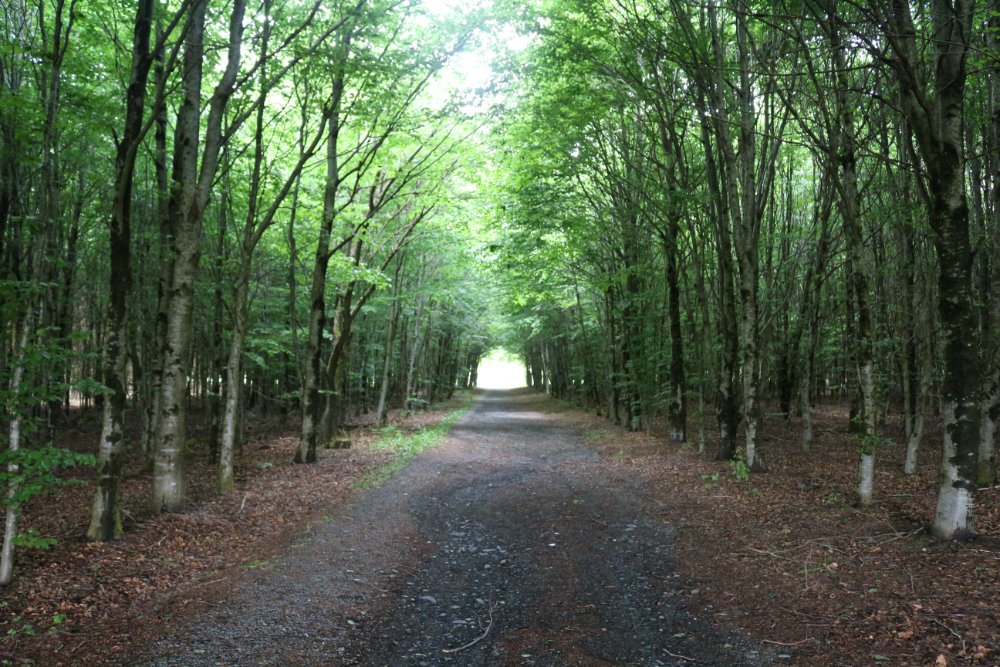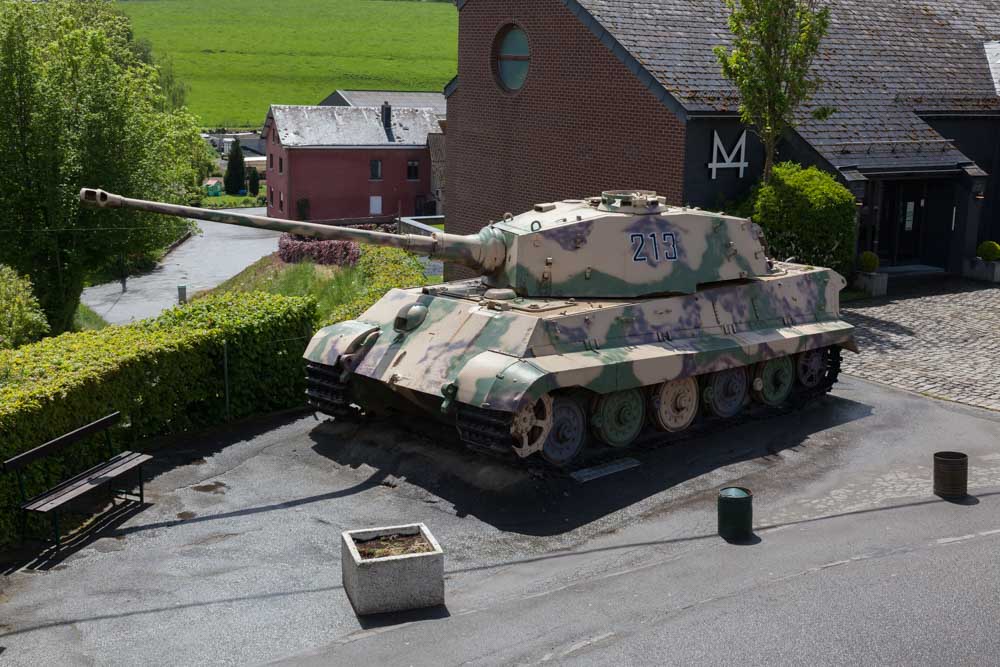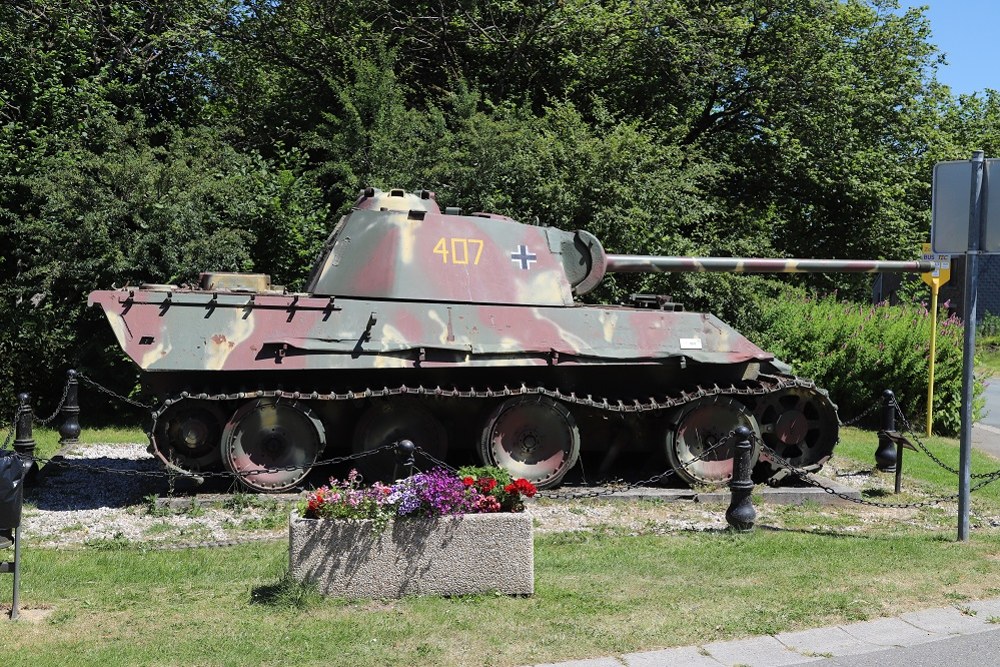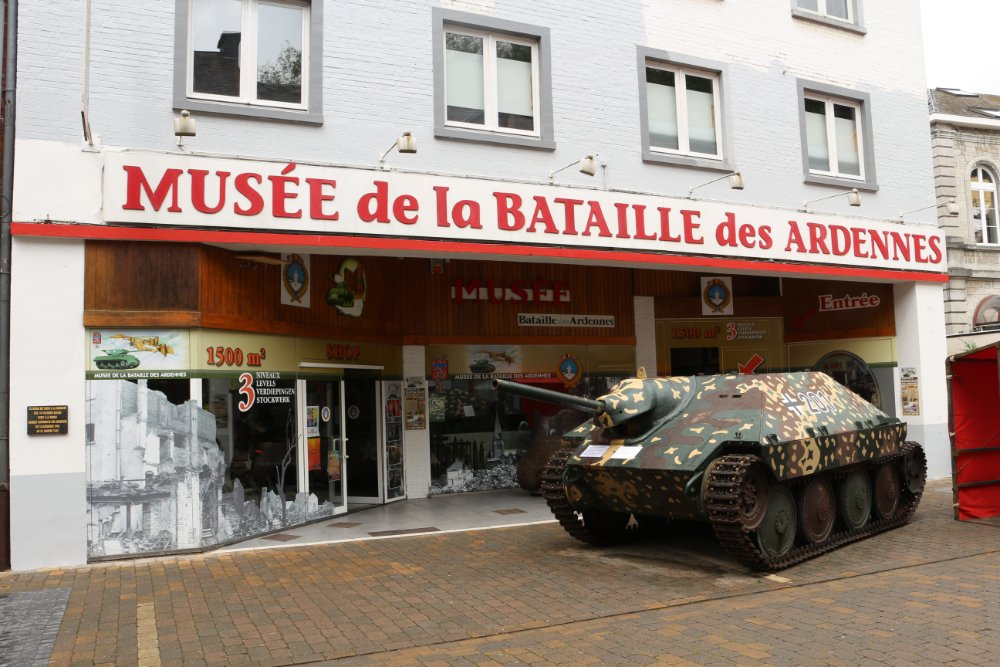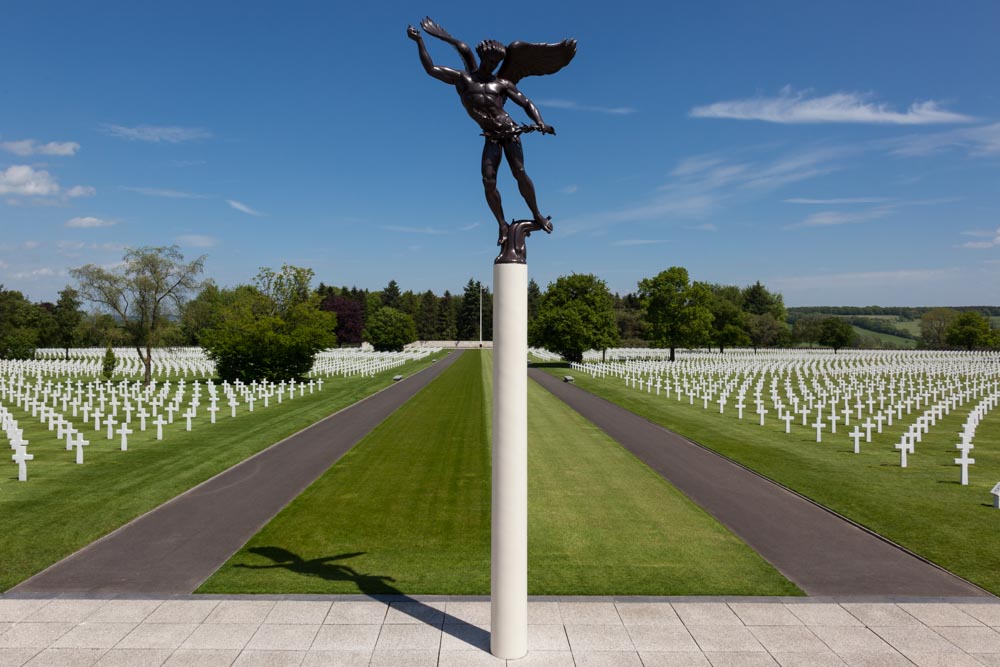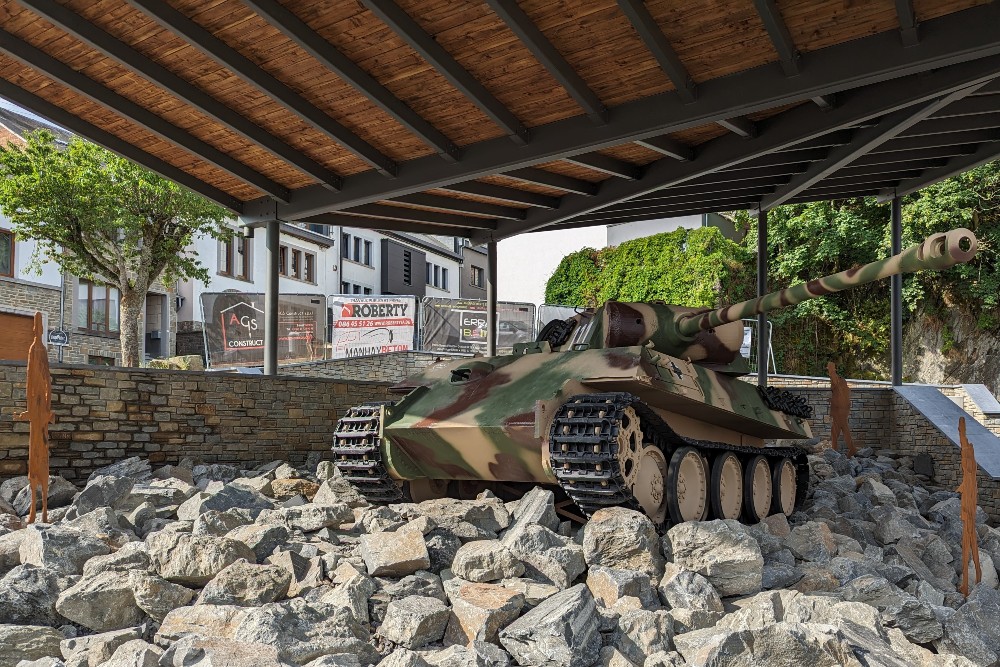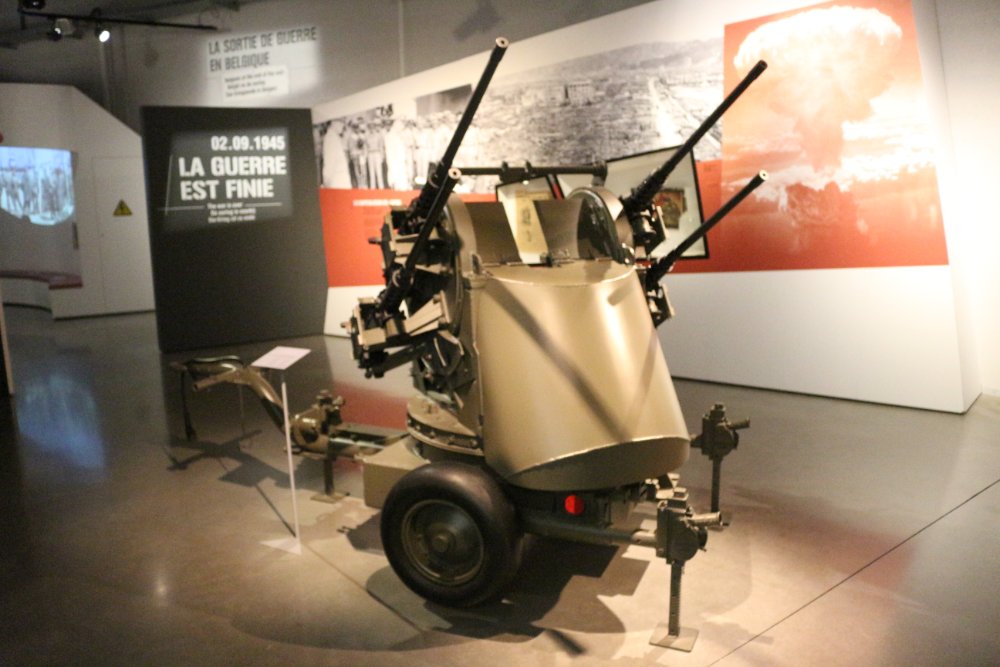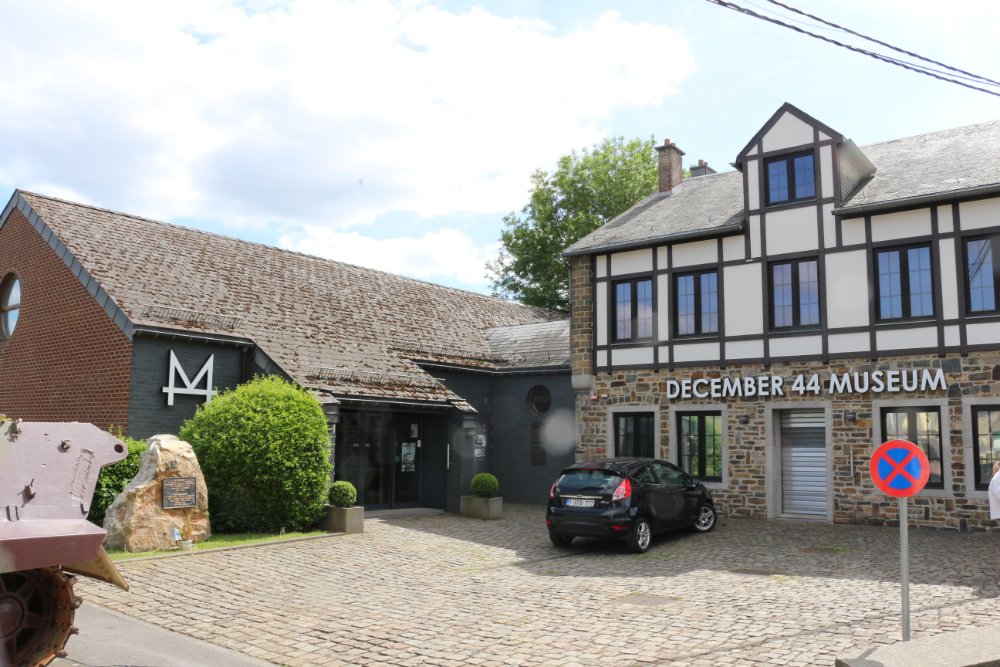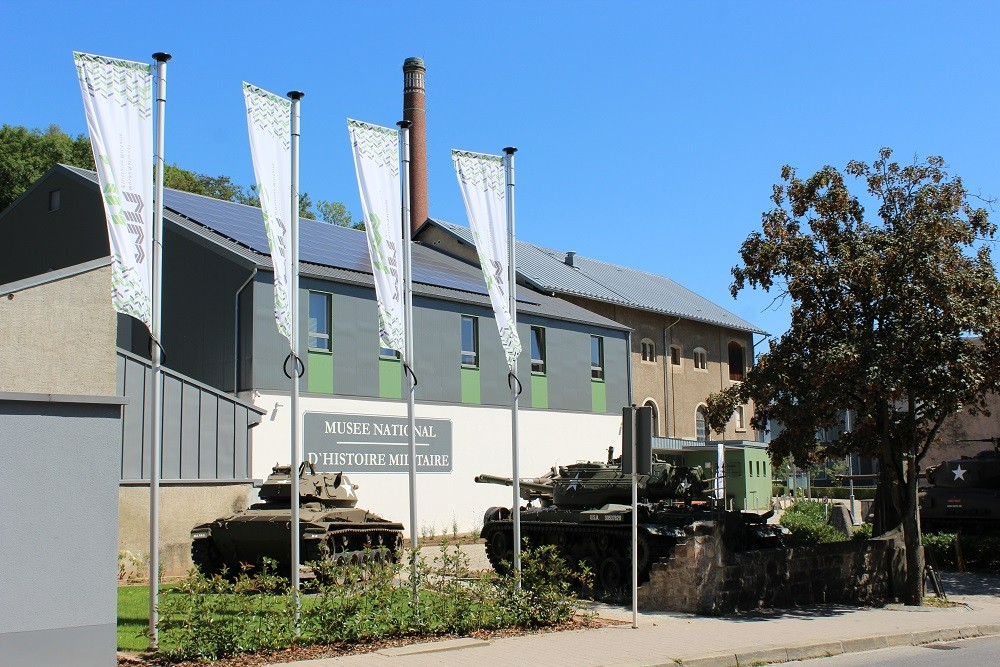Introduction
On 16 December 1944, the Germans launched a final large-scale offensive against the rapidly advancing Allied troops on the Western Front. No fewer than 24 German divisions were involved in the offensive. Many of these divisions had just been formed or were being re-equipped. The immediate objective of the German attack was to achieve a breakthrough through the Ardennes and thereby separate the British and American armed forces from one another. It was hoped that a break between these two allies would pave the way for peace negotiations. Adolf Hitler then wanted to advance further to Antwerp and recapture this crucial port. Due to an underestimation of German combat power and a failure of the intelligence services, the Allied troops were completely surprised by the German offensive. From 16 to 20 December 1944, German troops advanced to the towns of Stavelot, Sankt-Vith, Houffalize and Bastogne. Initially, chaos reigned among the Allies. Nevertheless, small Allied units succeeded in slowing down the German advance (for example in Bastogne). Bastogne was a strategic traffic junction in the Ardennes, controlling the north-south and east-west routes. The Allies intended to defend the small town at all costs. The battle for Bastogne delayed the German advance and proved crucial to the course of the offensive. The losses suffered by the Germans during the offensive determined the further course of the war.
Definitielijst
- offensive
- Attack on a smaller or larger scale.
Run-up to the offensive
In 1944, almost five years had passed since Germany invaded Poland. Despite the defeats in North Africa and on the Eastern Front, Germany still had Western Europe in its grip. After Poland, many other countries had been overrun by the Germans, such as France, Belgium, the Netherlands, Luxembourg, Norway, Denmark, Czechoslovakia, Romania and Russia. The Germans lost the Battle of Britain in the autumn of 1940, but that was one of the few setbacks on the Western Front up to that point. That changed in the spring of 1944.
Allied advance in France
After years of preparation, Allied forces crossed the Channel on 6 June 1944, D-Day, and set foot on the European mainland in Normandy. Despite the bad weather and the bloody fighting during the landing, D-Day was a success, and the Allies succeeded in establishing a bridgehead on the French coast. The final breakout took a long time to materialise due to Normandy’s dense hedgerow landscape that was difficult to get across, but once the breakout was achieved, the Allies could hardly be stopped. The armies advanced towards Paris at breakneck speed and the French capital was liberated on August 25, 1944, just seventy-seven days after D-Day. In the meantime, on August 1, the Allies had also landed in southern France to put even more pressure on the German troops. The Allies were doing so well that they thought they could end the war before the turn of the year. General Dwight Eisenhower was only in doubt about the fastest way to end the war. Should the Allied forces advance across a wide front into Germany or could the war be decided by a single powerful attack?
Market Garden
British Field Marshall Bernard Montgomery believed the latter to be the right approach. He convinced Eisenhower of his plan to advance via the city of Arnhem in the Netherlands to the Ruhr area, the industrial heart of Germany. Paratroopers from the 1st Allied Airborne Army would clear a corridor so that the tanks of the British XXX Corps could advance to Arnhem. There they would seize the bridge crossing the Rhine and turn off to the Ruhr area. If they could get there, they would be in the heart of the German war industry and the war could be over before Christmas. On September 17,1944, the operation, called Market Garden, started. The Allies soon fell behind schedule and the Germans managed to defeat the British airborne troops at the Arnhem roadway bridge. The British airborne troops were forced to surrender when the Allies ground to a halt a few kilometres from Arnhem.
Deadlock
As the advance had halted, the Allies set up a defensive line between Nijmegen and Arnhem. Eisenhower now preferred a wide front and wanted Montgomery to first ensure that all areas behind the front line were conquered. Therefore, an attack followed on the Scheldt estuary that gave access to the port of Antwerp in western Belgium. Then a huge battle broke out in the Hürtgenwald, east of the Belgian-German border. The Hürtgenwald was full of mines, barbed wire and bunkers. During this battle, five full American divisions were deployed, a total of about 120,000 men, of whom 33,000 were killed. In the meantime, the Allies had not paid much attention to the rest of the front. For example, in the Ardennes sector, a part of the front line of approximately 110 kilometres was covered by only four divisions of the 8th Corps. These divisions also often consisted of newly drafted, and therefore often inexperienced soldiers.
Definitielijst
- D-Day
- The day of the long awaited invasion of western Europe in Normandy, France, 6 June 1944. After a long campaign of deception the allies attacked the coast of Normandy on five beaches to begin their march on Nazi Germany. Often explained as Decision Day, though this is entirely correct. The D stands for Day as generally used in military language. In this case it means an operation beginning on day D at hour H. Hence “Jour J“ in French.
- Paratroopers
- Airborne Division. Military specialized in parachute landings.
The German intentions
While Montgomery made his plans for Market Garden known to Eisenhower, Adolf Hitler informed his key staff of his own plan for a surprise attack in the Ardennes. The offensive was to put an end to the Allied advance and turn the tide in the Germans' favour.
The situation of the Germans
During the winter of 1944, Germany had been at war with the Allies for more than five years. The heavy losses in France and Russia forced Hitler to announce a general mobilisation of men between the ages of 17 and 54. Sixteen-year-olds could volunteer for military service. Joseph Goebbels tried to boost the morale of the people by means of propaganda. He warned the population about the measures the Allies would take in the event of a German defeat. He put the German population on the spot: either prevail by waging a Totaler Krieg (Total War) or else be wiped out. Many chose the first option. These mobilisation measures provided the German army with about half a million additional soldiers.
Meanwhile, Hitler was busy working on his plan for a counterattack. The Russian armies’ advances had paused, and Hitler did not think they would be able to resume the offensive until February 1945, when the worst part of the winter was over. The German troops in Italy held their ground against the Allies. In the west, the advance of the Western Allies had halted because of the failure of Market Garden and the problems with their overextended supply lines. Hitler perceived this as the ideal moment for a lightning attack on one of the fronts. If this action were successful, more troops would be available for the other front and Germany would hold a strong position during any peace negotiations with the Western Allies.
In the autumn of 1944, the German armament industry had continued to expand, and more tanks, aircraft and other military equipment were produced than ever before. This enabled Hitler to arm the half million extra soldiers and even equip a completely new Panzer army. However, Albert Speer, the Reich Minister for Armaments and War Production, did point out to Hitler that these troops had to be deployed immediately, because if Germany had to give up even more territory, this would have major consequences for the war industry. For example, the loss of the Romanian oil fields of Ploesti or other areas that provided vital raw materials could result in the war industry coming to a standstill.
The situation of the Allies
As the advance of the Allies had reached an impasse after the failure of Operation Market Garden, Eisenhower now wanted to have the port of Antwerp at his disposal first. After all, the supply lines of the Allied armies still ran from the Normandy beaches where D-Day had taken place. Some armies had even advanced faster than they could be supplied and had been forced to come to a halt.
The front line in the Ardennes was occupied by units of the American VIII Corps, commanded by Lieutenant-General Troy Middleton. The length of the front occupied by the VIII Corps was 120 kilometres, three times longer than usual. Furthermore, the operational effectiveness of his troops was very low. For example, the northern part was occupied by the 14th Cavalry Reconnaissance, which lacked any combat experience. At St. Vith, the 106th Infantry Division had arrived after having completed its basic training in the United States only recently. A little further south was the 28th Infantry Division that had recently fought a heavy battle in the Hürtgen Forest, but now more than a third consisted of new replacements with no significant combat experience. The southern part of the line was occupied by the 4th Infantry Division. This unit had also just returned from the fighting in the Hürtgen Forest where it had lost 3,500 men but replacements had not yet arrived. The 9th Armored Division was also positioned at the front line, but it lacked any combat experience and its overall strength had been reduced by two armoured groups.
Although the Allied intelligence service had collected a considerable amount of information on the enemy forces, all of this was information that the Germans intended to reach the Allies. This information gave the impression that it was all about defensive actions. They were indeed aware of the positions of the 6th Panzerarmee in particular. Reconnaissance flights, intercepted messages and information from civilians had contributed to this.
Definitielijst
- Cavalry
- Originally the designation for mounted troops. During World War 2 the term was used for armoured units. Main tasks are reconnaissance, attack and support of infantry.
- D-Day
- The day of the long awaited invasion of western Europe in Normandy, France, 6 June 1944. After a long campaign of deception the allies attacked the coast of Normandy on five beaches to begin their march on Nazi Germany. Often explained as Decision Day, though this is entirely correct. The D stands for Day as generally used in military language. In this case it means an operation beginning on day D at hour H. Hence “Jour J“ in French.
- Infantry
- Foot soldiers of a given army.
- offensive
- Attack on a smaller or larger scale.
- propaganda
- Often misleading information used to gain support among supporters or to gain support. Often used to accomplish ideas and political goals.
Hitler's plan
While the Americans were fighting one of their bloodiest battles in the Hürtgenwald, preparations were underway in Germany for a huge offensive that was to replicate the German successes of 1940. The offensive was planned to take place in the weakest sector of the Allied front and to be launched by Heeresgruppe B (Army Group B), under the command of General Walter Model.
Wacht am Rhein
Hitler's plan was roughly as follows:
- The 5th (in the centre) and 6th (in the north) Panzerarmee were to break through the American lines at H hour. The flanks of these armies were to be guarded by units of the 7th (in the south) and 15th Armee (in the north).
- The 15th Armee, commanded by General Gustav von Zangen, was to prevent the American troops of the VII Corps and the American 9th Army from joining the battle in the north.
- The 6th Armee, commanded by Oberstgruppenführer (SS Lieutenant-General) Josef Dietrich, was to advance to Antwerp and seize the port. They would then have to advance further to isolate the Allied forces in the north.
- The 5th Panzerarmee, commanded by General Hasso von Manteuffel, had to advance further after breaking through the American lines, cross the Meuse River and capture Brussels to cover the flank of the 6th Armee.
- The 7th Armee, commanded by General Erich Brandenberger, had to conquer the Grand Duchy of Luxembourg and then advance further to cover the southern flank of the 5th Panzerarmee.
The advance of the 6th Armee was to be accelerated by two special operations. A group of paratroopers, commanded by Lieutenant-Colonel Friedrich von der Heydte, was to be dropped at Verviers (Operation Stösser). Their task was to capture several important traffic junctions. Further, the 150th Brigade under the command of Obersturmbannführer (SS Lieutenant-Colonel) Otto Skorzeny, was to capture the bridges at Amay and Huy. They were to be equipped with American uniforms and vehicles (Operation Greif). After capturing the bridges, they were to create as much mayhem as possible among the Allied troops in the Ardennes.
The attack was to be launched after a short but intense artillery bombardment. During the operation, the major cities of Liège and Antwerp were to be bombarded with V1 and V2 rocket missiles. Hour H was set for 0530 on the 16th of December. Antwerp was to be in German hands by December 23. Because the balance of power between the Allied and German armies turned against the Germans, the attack had to be a complete surprise. For this reason, the operation was kept top secret and only a few high-ranking officers were informed by Hitler in advance. To avoid interception by the Allies of German radio traffic, any communication related to the operation was only allowed by landlines (telephone and telegraph) and despatch riders. Yet, fabricated radio messages were leaked to the Allies about an impending counterattack elsewhere that was supposed to stop an Allied advance between the Ruhr and the Rhine rivers. A concentration of German troops would therefore not be too conspicuous for this reason. Even the code name of the operation, ‘Die Wacht am Rhein’ (The Watch on the Rhine), was used as a misguidance as it suggested a defensive manoeuvre.
Scepticism on Hitler’s plans
Many German commanders disagreed with Hitler's plan as many considered it too ambitious, or even completely unrealistic. Walter Model, Gerd von Rundstedt and Hasso von Manteuffel all had their doubts that the fuel required could be collected in time. Their concerns turned out to be justified. Hitler had assigned Generalfeldmarschall Wilhelm Keitel the task of securing the necessary 28 million litres of fuel, which he managed to do. However, only half of this had been assembled on the west bank of the Rhine from where the counterattack was to be launched. The rest was still in supply depots elsewhere.
Von Manteuffel had more reservations about Hitler's plan. The original starting date of the offensive was set at November 25, but at Von Manteuffel’s insistence this was changed to December 10. This was later moved again to the 14th. The time between the artillery bombardment and the infantry attack was also reduced. Initially, there would be 3.5 hours between them, so that the Luftwaffe could bomb the Allied headquarters in the Ardennes. Such a long time span seemed pointless to Von Manteuffel, because it would take the surprise out of the attack. This element of surprise was crucial, since the German infantry was no longer as good as in the early years of the war and because the timetable set by Hitler was very tight for an operation in such difficult to penetrate terrain as the Ardennes. Von Manteuffel later said of the plan: “It seemed to me foolish in many ways.”
Such statements were made by several German commanders and illustrate the distrust they had in a successful outcome of the operation. For example, Field Marshal Gerd von Rundstedt, who believed that many more divisions were needed to reach the Meuse River, said:
"It was clear that the available troops were far too few in number. But I had already discovered that it was pointless to argue with Hitler about the feasibility of anything."
The doubts of the German commanders were perhaps best expressed by SS-Obergruppenführer Josef Dietrich:
"All Hitler wants from me is to cross a river, capture Brussels and then advance and capture Antwerp. And all that in the worst time of the year, and through the Ardennes when the snow is hip-deep and there is no room to put four tanks in front, let alone to deploy Panzer divisions. A period when it is not yet light at 8 o'clock and dark again at 4 o'clock and all of that with re-organised divisions, mainly consisting of boys and sick old men - and at Christmas."
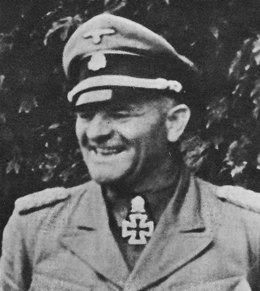
SS-Oberstgruppenführer Josef Dietrich had his doubts about the feasibility of the offensive. Source: US Army photo
Definitielijst
- Brigade
- Consisted mostly of two or more regiments. Could operate independently or as part of a division. Sometimes they were part of a corps instead of a division. In theory a brigade consisted of 5,000 to 7,000 men.
- Heeresgruppe
- The largest German ground formation and was directly subordinate to the OKH. Mainly consisting of a number of “Armeen” with few directly subordinate other units. A Heeresgruppe operated in a large area and could number several 100,000 men.
- infantry
- Foot soldiers of a given army.
- Luftwaffe
- German air force.
- Marshal
- Highest military rank, Army commander.
- offensive
- Attack on a smaller or larger scale.
- paratroopers
- Airborne Division. Military specialized in parachute landings.
- rocket
- A projectile propelled by a rearward facing series of explosions.
Initial attacks
On December 15,1944, at half past three in the afternoon, the German headquarters gave the order to start the counteroffensive. Thirteen infantry divisions, five armoured divisions and many supporting units had been assembled for this attack. In total, more than 200,000 men would take part in the operation. It took almost the entire evening and night for everyone to reach their positions and then wait for the hour H.
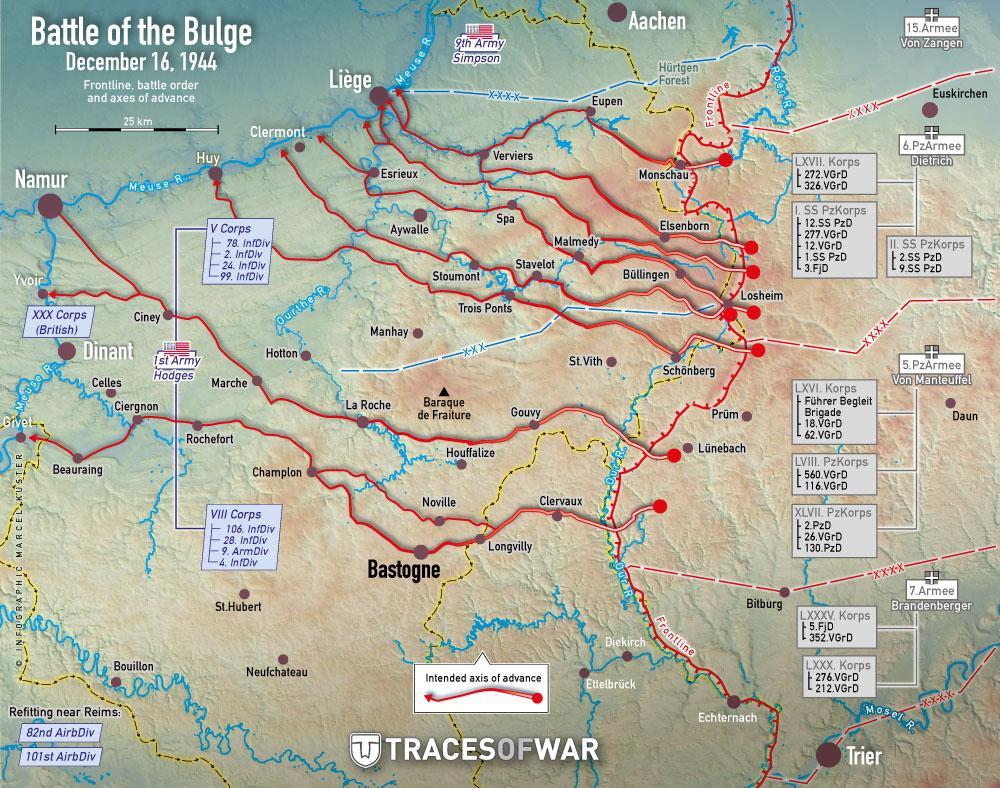
Frontline, battle order and axes of advance on December 16, 1944. Source: Marcel Kuster graphic design
Start of the offensive
At half past five in the morning of December 16, the barrage of German artillery broke loose. The Allied lines were fired upon for an hour by more than 200 pieces of artillery and rocket launchers, destroying houses, trees and vehicles. Also, the Americans suffered their first casualties, many of whom were still asleep. The shelling also disrupted the telephone connections making it impossible for many units to inform their commanders about the German actions. Those units that were able to do this needed so much time that the command posts were warned with a considerable delay. The German infantry advanced through the American lines and reached some of their objectives. This gave the armoured units the opportunity to start their advance on the evening of December 16. The surprise on the Allied side was enormous.
Nevertheless, the Germans encountered much resistance in the north and south. In the north, troops of the American 5th Corps managed to largely hold back the 6th SS Panzerarmee between Bütgenbach and Monschau. These American units were preparing for an attack on the dams in the Ruhr, which meant that they were ready for action when the Germans attacked. In the south, the American 4th Infantry Division, which had landed on Utah Beach on D-Day and was recovering in the Ardennes from the battle in the Hürtgenwald, held off the Germans. In the centre of the American front in the Ardennes, however, the Germans did manage to break through. The 28th Infantry Division fought against an enormous German superiority and was virtually destroyed. Two regiments of the 106th Infantry Division were surrounded. They managed to hold out for three more days but were unable to break out. The division lost 7,000 men. It was complete chaos on the American front line. Messages were not properly received or in some cases were not taken seriously, which indicated that the Allied command initially had no idea of what was happening in the Ardennes.
Special operations
Hitler had made room for two special operations in his plan for ‘Wacht am Rhein’. Leutnant-Colonel Friedrich von der Heydte had to occupy and hold several important traffic points near Verviers with his paratroopers. This had previously been Malmédy and the roads around Baraque Michel but was later changed. However, due to a lack of fuel, there were no trucks available to transport his paratroopers to the airfield. His operation, code-named Stösser (Sparrowhawk), was therefore postponed by a day.
At two o’clock in the early morning of December 17, the paratroopers took off anyway. As a result of a strong wind, American anti-aircraft gunfire, inexperienced German pilots and poor preparation, only 35 of the 106 Junkers transport aircraft reached the dropping zone. Von der Heydte only managed to assemble 300 men on the ground. The heavy weapons that were supposed to serve as support had not arrived. Ambushes were set up for the Americans. American attacks caused casualties on both sides. Von der Heydte soon realised that he could not hold out for long because he had too few men and ammunition to successfully complete his operation. He decided to return to the German lines at Monschau. The paratroopers dispersed and began their retreat. Von der Heydte himself was captured when he encountered American soldiers at Monschau on December 22.
The other special operation was codenamed Greif in which SS-Obersturmbannführer Otto Skorzeny and his Panzerbrigade 150 had to capture the bridges at Amay and Huy. The brigade consisted of 120 men. These were supposed to be men who spoke English and were dressed in American uniforms. However, it turned out that there were far too few uniforms available and only ten men were fluent in English. There were also only a few American vehicles available. To solve this, a few German tanks were disguised as M-10 tank destroyers.
Eventually, eight jeeps managed to slip through the Allied lines. Five of these jeeps were intercepted and their occupants were convicted as spies and shot. Three jeeps returned to the German lines empty-handed. Operation Greif had failed in terms of capturing the bridges. However, the operation caused great confusion within the American lines. Every American soldier was bombarded with questions that a ‘real’ American would have to know to make sure it wasn’t one of Skorzeny’s men. Eisenhower was even given extra security, because rumours were going around that these commandos were sent to assassinate the Allied Supreme Commander.
War crimes
SS-Obersturmbannführer Joachim Peiper and his Kampfgruppe played a major role during the German offensive and his troops would spearhead the attack. Peiper was known for his enormous fighting spirit and ruthlessness and in Russia, his troops had caused terrible havoc. Kampfgruppe Peiper also became notorious for their actions in the Ardennes. During their advance, they killed both civilians and prisoners of war at several locations. There is still much uncertainty and controversy about the exact number of victims, the precise circumstances and the perpetrators. In any case, Peiper was eager to force a lightning breakthrough in the Ardennes and reach Antwerp. To his dismay, the breakthrough was delayed by a blown-up bridge at Losheim and stubborn American resistance at Lanzerath.
Once the Germans had crushed the defence of Lanzerath, they advanced further, only to encounter resistance again at Honsfeld. Meanwhile, the main body of Kampfgruppe Peiper was on its way to Büllingen, where an American fuel depot was located. In order to continue his advance, Peiper had to capture American fuel, as he had not received enough supplies. After the German tanks had been refuelled, they advanced further to Malmédy. En route, an event took place that would greatly define the notorious reputation of Kampfgruppe Peiper. In a meadow along the N-23 route, near a crossroads, 86 American prisoners of war were herded together and then killed. The mass execution became known as the Malmédy Massacre.
There are many different stories about what exactly happened in Baugnez. At the time, the American army made it seem like a deliberate mass execution, and some historians still hold on to that today. Other researchers claim that the Americans attempted a mass escape, causing the German troops to open fire. A middle ground between the two scenarios is being sought by others. We will probably never know exactly what happened, but the fact is that some of the victims had been shot in the head at close range. This gruesome discovery had a major impact on the morale of the American soldiers during the Battle of the Bulge. Rumours about the mass execution in Baugnez spread rapidly through the lines. The soldiers were furious, their resistance became even more determined, and they were no longer prepared to surrender for fear of being murdered afterwards.
Definitielijst
- brigade
- Consisted mostly of two or more regiments. Could operate independently or as part of a division. Sometimes they were part of a corps instead of a division. In theory a brigade consisted of 5,000 to 7,000 men.
- D-Day
- The day of the long awaited invasion of western Europe in Normandy, France, 6 June 1944. After a long campaign of deception the allies attacked the coast of Normandy on five beaches to begin their march on Nazi Germany. Often explained as Decision Day, though this is entirely correct. The D stands for Day as generally used in military language. In this case it means an operation beginning on day D at hour H. Hence “Jour J“ in French.
- infantry
- Foot soldiers of a given army.
- Kampfgruppe
- Temporary military formation in the German army, composed of various units such as armoured division, infantry, artillery, anti-tank units and sometimes engineers, with a special assignment on the battlefield. These Kampfgruppen were usually named after the commander.
- offensive
- Attack on a smaller or larger scale.
- paratroopers
- Airborne Division. Military specialized in parachute landings.
- resistance
- Resistance against the enemy. Often also with armed resources.
- rocket
- A projectile propelled by a rearward facing series of explosions.
- shelling
- Indication for shooting targets with grenades. Both from artillery and armoured artillery.
The Allies hold their ground
The Germans had forced a breakthrough in the middle of the American lines with lightning speed.
At the beginning of their offensive, the Germans were mainly bothered by small, isolated groups of Americans. However, the further they advanced, the more they encountered larger and more organised pockets of resistance. The shock of the offensive may have been intense at the start, but the Americans would not simply let the Germans advance to the Maas. The rumours about the murders of the prisoners of war also contributed to the Americans’ determination to resist the assault.
Northern pockets of resistance
The American 2nd Infantry Division, commanded by Major General Walter Robertson, was assigned to defend the Elsenborn Ridge. His division was supported by loose formations from the 99th Infantry Division, which had become separated from their own division. The Elsenborn Ridge is a boomerang-shaped high ground that dominated the northern route to the Meuse River and was of great strategic importance to the Germans. The 12th and 277th Volksgrenadier Divisions were to capture the area so that the 12th SS Panzer Division could advance further. The Germans conducted several fierce attacks to take control of the small villages of Rocherath and Krinkelt. Although they succeeded to enter the villages and threatened to break through the American lines, many German tanks were knocked out by bazooka teams, Shermans and tank destroyers. On 19 December, Robertson decided to withdraw his men from the villages to the Elsenborn plateau, as the Germans were throwing fresh troops into the battle with the 3rd Panzergrenadier Division. The Americans were supported by the 1st Infantry Division, which was to defend the terrain at the village of Bütgenbach where they encountered some tanks from the 12th SS-Panzerdivision Hitlerjugend, which were trying to bypass the Elsenborn ridge to reinforce Kampfgruppe Peiper. The American divisions had dug in on the higher ground. The Germans reportedly made seven attempts to take the hills, but were unsuccessful, partly due to American artillery. The Germans had suffered heavy losses in the battle for the Elsenborn ridge, and Dietrich's Panzer divisions now turned south to capture Sankt-Vith in order to advance further to the Meuse River.
Sankt-Vith is a small town located about 15 kilometers from the German border. Six major roads pass through the town, including those to Huy, Liège and Antwerp. The former cities are located on the Meuse River, and Antwerp was the main objective for the Germans. Sankt-Vith was the headquarters of the 106th Infantry Division, commanded by General-Major Alan Jones. The German commanders agreed that the town had to be captured at all costs, and the 18th and 62nd Volksgrenadier Divisions, supported by the Führer Begleit Brigade, were to carry out the attack. The defence of Sankt-Vith consisted of the men of the headquarters of the 106th Infantry Division, remnants of the 14th Cavalry Regiment, two battalions of engineers and Combat Command B of the 7th Armored Division. They dug themselves into a horseshoe-shaped defence. As the days went by, the defenders were reinforced by some of the survivors of the initial German attacks on the 424th Infantry Regiment. The Germans were stronger, and the Americans had to give ground, but they resisted so stubbornly that Sankt Vith became a major breakwater in the German advance, whereby the Führer Begleit Brigade lost a number of tanks. In the meantime, the remainder of the 112th Infantry Regiment of the 28th Infantry Division, which had been badly hit during the start of the offensive, were joined by units of the 9th Armored Division. If the 560th Volksgrenadier Division and the 116th Panzer Division had advanced to Houffalize, Sankt Vith would have been surrounded. A major German attack followed on the 23rd. The Americans were forced to withdraw from the town, which was quickly captured by the Germans. During the retreat, many more men were killed and tanks destroyed by the Germans. More than five thousand Americans lost their lives, but the defenders of Sankt Vith had managed to considerably slow down the German advance.
Southern pockets of resistance
In the south, the German 7th Army of General der Panzertruppen Erich Brandenberger also encountered considerable resistance. His troops had to cover the left flank of General Von Manteuffel's advance. The main American units they encountered here were the 4th Infantry Division and the 2nd Armored Division. The 4th Infantry was a unit that earlier had suffered heavy blows during the battle in the Hürtgenwald.
During the early start of the offensive, the American infantry was under severe attack. However, during the day they were able to recover and even carry out small counterattacks here and there. The primary objective of the Germans in the south, capturing the bridges over the Our so that Von Manteuffel could advance to Oberwampach and Bastogne, was not achieved. They had been stopped by the American infantry and the engineers had been able to blow up the bridges over the Our and to set up barricades. New pontoon bridges had to be built, and the delay had now increased to a day. However, the Germans had taken Diekirch in Luxembourg and Clervaux in the evening.
Once their pontoon bridges allowed the Germans to cross the river, the Americans were only able to slow down the German advance in the Grand Duchy of Luxembourg. The Germans had so many armoured vehicles and artillery that the American units were unable to stop the advance. Nonetheless, the Americans defended the numerous small villages with all the resources they had at their disposal. Even cooks, office staff and the military police were deployed. There was heavy fighting for the villages of Manarch, Heinerscheid and Wiltz, where the American artillery managed to knock out a few German guns. As the Germans advanced further and captured village after village, defensive positions were taken up at Hosingen and Consthum on the retreat. On the 18th, 300 Americans were captured. The remainder repelled several attacks on Consthum and managed to escape in the fog. Several thousand soldiers were killed during the fighting in Luxembourg. However, the tough resistance had saved valuable time to set up the defence of the largest and best-known southern resistance centre: Bastogne.
Definitielijst
- bazooka
- American antitank rocket launcher weapon. Rocket with shaped charge is put in a long tube which is electrically fired from the shoulder of an infantry man. The bazooka can be reloaded. The bazooka produces a large flame to the rear which makes it unsuitable for fighting from closed compartments or from homes. British counterpart is the PIAT, Projector Infantry, Anti- Tank, also a man-portable anti-tank weapon. Germany used Panzerfaust and Panzerschreck, “armour fist “ and “armour terror”.
- Brigade
- Consisted mostly of two or more regiments. Could operate independently or as part of a division. Sometimes they were part of a corps instead of a division. In theory a brigade consisted of 5,000 to 7,000 men.
- Cavalry
- Originally the designation for mounted troops. During World War 2 the term was used for armoured units. Main tasks are reconnaissance, attack and support of infantry.
- Führer
- German word for leader. During his reign of power Adolf Hitler was Führer of Nazi Germany.
- Infantry
- Foot soldiers of a given army.
- Kampfgruppe
- Temporary military formation in the German army, composed of various units such as armoured division, infantry, artillery, anti-tank units and sometimes engineers, with a special assignment on the battlefield. These Kampfgruppen were usually named after the commander.
- offensive
- Attack on a smaller or larger scale.
- Regiment
- Part of a division. A division divided into a number of regiments. In the army traditionally the name of the major organised unit of one type of weapon.
- resistance
- Resistance against the enemy. Often also with armed resources.
The German offensive stalls
The German offensive had already fallen behind schedule by almost a week, and the problems were beginning to pile up for them. The Americans had brought many reserves to the front within a week’s time and were now able to block the access routes to the Meuse River. The Germans failed to capture the important fuel depot at Francorchamps and the lack of fuel brought their advance to a halt. Further, to ensure smooth logistics of necessary supplies, the Germans were dependent on Bastogne, but this town had still not been seized from the Americans.
Montgomery and the British
The German advance had severed the communication lines between General Omar Bradley’s HQ in Luxembourg, south of the Ardennes, and his First and Fifth Armies in the north of the Ardennes. Eisenhower had no other choice than to place these American units under the command of Field-Marshall Bernard Montgomery. George Patton was firmly in charge of the other half of Bradley's Army Group in the south, his Third Army. Bradley was rather upset about this, since he now had virtually nothing to do while his armies were under attack.
Montgomery, like Patton, had expected to be called upon by Eisenhower. However, his tactics differed from Patton's. Where the American went on the offensive, Montgomery regrouped the Allied front in preparation for a counterattack. Montgomery had moved the XXX Corps and infantry towards the battlefield and wanted to prevent the Germans from crossing the Meuse. The bridges over the Meuse were defended by the XXX Corps and armoured patrols were carried out by British units. They regularly encountered the spearheads of the German advance. The American 7th Corps was designated by Montgomery as a reserve unit for offensive actions.
However, the German armoured troops would never reach the Meuse. The advance came to a standstill because of small-scale Allied counterattacks and a lack of fuel. The armoured divisions had also been battered by attacks by Allied aircraft. General-Major Joseph Collins, commander of the American 7th Corps, gave the order to counter-attack. The American 2nd Armored Division and British Typhoons assaulted four German armoured divisions, the Panzer Lehr Division (the elite tank instruction division), the 2nd, 9th and 116th Panzer Divisions, thus ending the offensive threats of these German units just before Christmas.
Peiper comes to a standstill
Peiper was convinced that he could reach the Meuse with his Kampfgruppe in two days. After four days, he had only covered about half of the 95 kilometres and had come to a virtual standstill in the vicinity of Stoumont and La Gleize. In addition, the Americans had retaken Stavelot and blown up the bridges at Trois Ponts, cutting Peiper off from the rest of the 1. SS-Panzer-Division. As a result of continuous ground attacks, artillery bombardments and air attacks, he lost more and more men. The loss of armoured vehicles was remarkably low considering the many attacks: Peiper had lost only 13. In the meantime, he had even received reinforcements in the form of seven PzKpfw VI Tiger tanks. These Tigers were already part of his unit but always drove in the rear-end of his column. Now they had come forward. Peiper realised that the fighting in the vicinity of Stoumont and La Gleize had reached a hopeless deadlock and decided to gather his troops in the latter town. The Germans had the bridge across the Amblève River at Cheneux as their only way out. Here, heavy fighting took place between German infantry, armoured SS troops and the 82nd Airborne Division. The paratroopers had initially been sent to Bastogne but had changed course en route to be deployed at Werbomont, where they fought fierce battles with Kampfgruppe Peiper and the 1. SS-Panzer-Division. SS-Oberführer Wilhelm Mohnke, commander of the 1. SS-Panzer-Division, tried to reconnect with Peiper's troops here.
Peiper himself knew only too well that he would no longer manage to reach the Meuse River. He therefore wanted to withdraw his troops on the 23rd, but this was forbidden by Mohnke. Then followed a heavy attack by American infantry and tanks. In the meantime, the positions of Kampfgruppe Peiper were almost constantly bombarded by artillery. Peiper had all secret documents relating to the offensive burned and prepared for withdrawal. It was not until late in the afternoon that headquarters finally granted permission and his troops started to withdraw. At the beginning of the eight-day campaign of his Kampfgruppe, Peiper had 4,000 men at his disposal, to which another 1,800 men were added later. Only 800 Germans from Kampfgruppe Peiper managed to escape La Gleize. The Germans were now forced onto the defensive. Nevertheless, they did not give up. If they could capture Bastogne, they could quickly move their rearguard troops across the entire area and perhaps resume the offensive. Seizing Bastogne was the last chance for the Germans to turn ‘Wacht am Rhein’ into a success.
Definitielijst
- infantry
- Foot soldiers of a given army.
- Kampfgruppe
- Temporary military formation in the German army, composed of various units such as armoured division, infantry, artillery, anti-tank units and sometimes engineers, with a special assignment on the battlefield. These Kampfgruppen were usually named after the commander.
- offensive
- Attack on a smaller or larger scale.
- paratroopers
- Airborne Division. Military specialized in parachute landings.
The battle of Bastogne
The 101st Airborne Division was ordered to occupy Bastogne almost immediately after the start of the German offensive. Bastogne is an important road junction in the Ardennes region and Eisenhower was fully aware that the Germans needed Bastogne, especially if their advance were to be delayed. Therefore, the town had to remain under Allied control. The command of the division that would defend Bastogne was temporarily in the hands of Brigadier-General Anthony McAuliffe, because the actual commander, General Maxwell Taylor, was in the United States.
Encirclement
The men of the 101st Airborne Division had to leave for Bastogne so quickly that some did not even have the opportunity to pick up their weapons from the workshop. On the way to Bastogne, the trucks in which the men of the 101st Airborne Division were transported drove with high beam headlights to speed up the process. This was of course a big gamble, since it made the convoy very vulnerable to attacks by air. Meanwhile, three battle groups formed from Combat Command B of the 10th Armored Division had to hold off the Germans in the villages around Bastogne. Near Bastogne, the paratroopers continued on foot and encountered several American soldiers who were panicking or wounded and had fled. Many paratroopers managed to get weapons, ammunition, food and medical supplies from them. Some extra ammunition was hastily supplied as well, but the 101st Airborne Division nevertheless had to defend Bastogne with a shortage of almost everything.
The 101st Airborne Division arrived in the vicinity of Bastogne on the afternoon of 18 December. McAuliffe sent his regiments to join the battle groups that were fighting hard in the villages of Neffe, Noville and Foy against the 26th Volksgrenadier Division, the 2nd Panzer Division and the Panzer Lehr Division. After some heavy combat the Americans withdrew. McAuliffe now had the 101st Airborne Division, Combat Command B of the 10th Armored Division and the 705th Tank Destroyer Battalion of the 9th Army at his disposal. He instructed his troops to set up a defensive perimeter around the town with seven artillery battalions in its center. The Germans made a few more attacks on the outer edges of the defence lines, but these were repelled thanks to the artillery. The Germans now continued their encirclement of Bastogne, but retreat was no longer an option for the Americans and McAuliffe assured that the town would be held. December 20, 21 and 22 were relatively quiet days in the surrounded Bastogne. The Germans prepared a major attack to decide the Battle for Bastogne in their favour.
Meanwhile, on 19 December, a meeting had taken place in Verdun, attended by the main Allied commanders. Field-Marshall Bernard Montgomery was the notable absentee; he was represented by his chief of staff, General-Major Sir Francis de Guingand. One of the main topics at this meeting was of course the encircled Bastogne. General George Patton was asked how quickly he could turn his armies north to launch an attack towards Bastogne. He replied that this could be achieved within two days, which was doubted by the other Allied commanders. However, Patton had already prepared his plans prior to the meeting and took on the task of relieving the paratroopers of the 101st Airborne Division.
German attacks
On 22 December, the Germans made General McAuliffe a proposal to surrender. However, the American commander dismissed this ultimatum with the infamous cry:"Nuts!" The General der Panzertruppen Hasso von Manteuffel was furious when he learned about this, and ordered Bastogne to be bombed. The next day, December 23, the weather cleared and the defenders of Bastogne were supplied by air. However, the period of clear weather also worked to the advantage of the Germans and in the evening they launched an attack to the southeast. Colonel Heinz Kokott was in command. He seemed to have forced a breakthrough towards Bastogne, but the gap in the American line was closed on time. On Christmas Eve, the German bombers that Von Manteuffel had threatened with appeared over Bastogne. A heavy bombardment followed, destroying large parts of the town.
On Christmas Day, a large-scale assault on Bastogne followed whereby the Germans broke through the lines of the paratroopers, who were pushed back to the woods surrounding the town where they were able to stop any further German advance. Several tanks were also knocked out. German tanks took Hemroulle, after which a tank commander reported to Kokott that the tanks were in Bastogne. The German tanks stopped and were knocked out by the Americans. On December 26, Kokott launched another attack to break through to Bastogne, but this attack was nothing compared to the attack that had taken place on December 25. The attack was therefore repulsed quite easily.
In the evening of the 22nd, Patton's troops had only advanced eleven kilometres, which was nonetheless a remarkably large distance considering the snow and fog. This bad weather even incited Patton to pray for better weather. In the afternoon of December 23, the weather cleared up. Supplies were dropped over Bastogne and fighter planes attacked the Germans. Patton was able to get closer and closer to the besieged town. The attack of December 26 would be Kokott's last attack on Bastogne. The vanguard of General Patton's 3rd Army was only six kilometres away from the town. Later that day, the American 37th Tank Battalion under the command of Lieutenant-Colonel Creighton Abrams broke through the German lines south of the Bastogne and unlocked the encirclement.
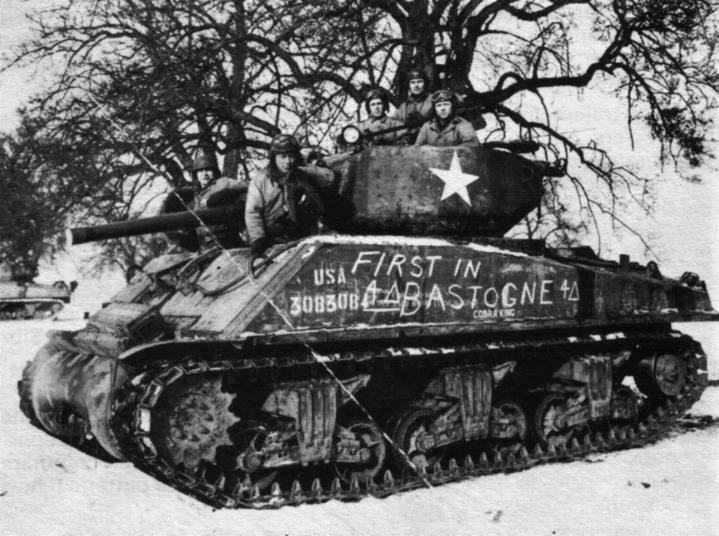
The tank of First Lieutenant Charles P. Boggess, who was the first to arrive in Bastogne. Source: U.S. Army photo
Definitielijst
- Destroyer
- Very light, fast and agile warship, intended to destroy large enemy ships by surprise attack and eliminating them by using torpedoes.
- offensive
- Attack on a smaller or larger scale.
- paratroopers
- Airborne Division. Military specialized in parachute landings.
The final German convulsions
Despite the Allies having liberated Bastogne, the battle for this town was not yet over. The Germans made a few more attempts to capture the town in order to keep alive the hope of a successful outcome of the offensive. However, Hitler still had two trump cards up his sleeve to turn the tide in the Ardennes.
Operation Nordwind
On New Year's Eve, Hitler launched a new offensive against the Allies. This time in Alsace against the troops of the 6th Army Group, which was under the command of General Jacob Devers. Nine German divisions were involved in this offensive, called Operation Nordwind. Hitler tried to use this operation to force General Patton to withdraw from the Ardennes in order to protect his lines of communication. If Patton were to withdraw, the tide in the Ardennes could turn again in the Germans' favour.
General Devers initially had to let his troops fall back. This caused some panic among his men. Thanks to Ultra, the collective name for German messages intercepted by means of deciphering, Devers was well informed about the German plans. The 101st Airborne Division had to close the gap in the American lines in the Alsace, which had arisen after the launch of Nordwind. Having just fought at Bastogne, it had become much feared by the Germans.
Within a week, the German attack had already been repelled by the Allies. In the end, the Allied positions had not been seriously threatened. American fears of a major German breakthrough were therefore unfounded, as Devers was able to hold out with his troops, although this only became clear in mid-January.
Operation Bodenplatte
Hitler launched a new attack on the Allies on 1 January. It was Operation Bodenplatte (baseplate), an attack by the Luftwaffe on the airfields of the Allied tactical air forces in Belgium, the Netherlands and Northern France. Every German pilot was used, even high-ranking officers and flight instructors. This operation was intended to restore the balance between the Allied air forces and the Luftwaffe. If this balance were restored, Hitler hoped to regain the initiative on the Western Front with his new jet aircraft. The operation had been thoroughly prepared from 15 December but could not finally begin until 1 January due to the bad weather conditions. Attacks on Allied bases were carried out from every Luftwaffe base that day.
Operation Bodenplatte, however, ended in disaster. The Allies lost only a small percentage of the number of aircraft they had at their disposal. The Luftwaffe, on the other hand, lost more than 300 aircraft and more than 200 pilots, including many flight instructors and a few very experienced pilots. Nevertheless, the Allies were once again surprised by the Germans with Bodenplatte. Moreover, the Allied airfields appeared to be poorly defended against an attack by the Luftwaffe. The air superiority over Europe had ensured that less and less attention had been paid to this.
Definitielijst
- Luftwaffe
- German air force.
- mid
- Military intelligence service.
- offensive
- Attack on a smaller or larger scale.
- Ultra
- British intelligence service during World War 2
The tables turned
The spearhead of the German attack, Kampfgruppe Peiper, had come to a standstill near the Meuse. The unit had been surrounded, attacked and forced to withdraw. The British XXX Corps had abandoned its defensive positions and pushed the Germans away from the Meuse. Bastogne was no longer surrounded now that contact had been made with Patton's ground forces. "Wacht am Rhein" seemed to have failed, but a German defeat in the Ardennes was far from certain. Hitler did not want to give up yet. He was still convinced that Germany would emerge as the winner. So did Walter Model. He described the current situation in the Ardennes as follows: "Germany is now engaged in a war of attrition, which will entangle and crush the Allies."
Allied counterattack
General Dwight Eisenhower faced a difficult decision. Many Allied troops were exhausted and many men had been lost. There were not enough reserves available to replace the losses. Perhaps it was too much to ask the men to attack now, but the ongoing battles in the Ardennes had not yet been won and could therefore still take an unfavourable turn. With the help of a quick counterattack, the Allies could take advantage of the Germans' lack of supplies and reinforcements and thus decide the Battle of the Ardennes in their favour. This was what Eisenhower chose, despite the Allies' precarious situation.
High Command decided that the counterattack would consist of two major offensives. The 3rd Army would launch an offensive from Bastogne and the 1st Army would do the same toward Sankt-Vith. The two armies were then to converge at Houffalize, a small town in the middle of the Ardennes. According to Eisenhower, this counterattack would give the Allies a decisive victory in the Ardennes. This victory was to be followed by an advance to the German border through the Ardennes and the Eifel, and then northwest toward the Rhine.
The attacks began on January 3, 1945. The 1st Army advanced toward Houffalize, Sankt-Vith, and the Elsenborn plateau. In the south, the 3rd Army also advanced from Bastogne toward Houffalize. The German commanders realised that the pressure exerted by the Allies was too heavy and knew that they could not advance any further. However, Hitler, as always, wanted every piece of conquered ground to be defended to the last man. So, the German commanders decided to fight a retreat in order to slow down the Allied advance as much as possible. In the southern Ardennes, the 4th, 5th and 80th Infantry Divisions were engaged in a war of attrition with the 7. Armee around Echternach and Diekirch.
Meanwhile, Winston Churchill urged Joseph Stalin to start the upcoming Russian winter offensive as soon as possible to reduce the pressure on the Western Allies. Although progress was being made in the Ardennes, the advance was far from rapid. The two attacking armies were still receiving several heavy blows from the Germans, who had entrenched themselves in almost every village with anti-tank weapons and machine guns. Every road junction was also riddled with mines. As a result, the British and Americans had to fight hard for every meter.
Retreat to the German border
Nevertheless, on January 9, 1945, Hitler seemed to abandon hope of a victory in the Ardennes. He moved the 6th SS Panzer Army to Hungary and all new troops and tanks had to be sent to the Eastern Front. In the meantime, the Allied air force had heavily bombarded the town of Houffalize, the target of their counterattack. The town was virtually razed to the ground and the 9th SS Panzer Division was all but wiped out. The air force had an important role to play in the fighting in January anyway. Due to improved weather conditions, many missions could be flown. The German armoured formations, which often suffered from a lack of fuel, were easy prey for the Allied pilots.
On 16 January, units of the 2nd and 11th Armored Divisions linked up in Houffalize. The German offensive was now definitely over. The Allied offensive, however, was not: the counterattack had succeeded, but they still had to fight their way back to the German border. The Allied commanders wanted to advance as quickly as possible and eliminate as many Germans as possible now that they had the opportunity. The Allied air force played an important role in this as well. The bridges and intersections on the German escape routes were heavily attacked. The columns of German tanks, supply trucks and guns were also bombarded almost continuously from the air.
On January 23, the 7th Armored Division recaptured Sankt-Vith from the Germans. In the period from January 23 to 25, the villages of Baugnez, Malmédy, Vielsam, Clervaux and Diekirch were also recaptured. By January 26, there were only a handful of German pockets of resistance left in the Ardennes. After these had been cleared, January 28 was designated by the American army as the end date for the Ardennes offensive.
Definitielijst
- Ardennes offensive
- Battle of the Bulge, “Von Rundstedt offensive“ or “die Wacht am Rhein“. Final large German offensive in the west from December 1944 through January 1945.
- Infantry
- Foot soldiers of a given army.
- Kampfgruppe
- Temporary military formation in the German army, composed of various units such as armoured division, infantry, artillery, anti-tank units and sometimes engineers, with a special assignment on the battlefield. These Kampfgruppen were usually named after the commander.
- offensive
- Attack on a smaller or larger scale.
- resistance
- Resistance against the enemy. Often also with armed resources.
Epilogue
Hitler took a huge risk with "Wacht am Rhein". He committed valuable men, tanks and vehicles to reach Antwerp, an objective that was and still is considered unrealistic by many German officers and historians. But no one dared to contradict the Führer and the capture of Antwerp was Hitler’s last hope to defeat the Western Allies.
Losses
The Americans had committed no less than 600,000 troops during the Battle of the Bulge. Among them, 100,000 casualties had fallen, of which 19,000 were killed and 15,000 were taken prisoner. The British had thrown 55,000 men into the battle. They had lost 1,400 men, of which 200 were killed. The 28 divisions that the Germans had committed consisted of more than 500,000 soldiers. The Germans suffered 130,000 casualties, of which 19,000 were killed. Both sides are also said to have lost around 800 armoured vehicles each. The Luftwaffe was virtually eliminated as a result of Operation Bodenplatte.
The big difference between the Allies and the Germans, however, was that the former could still make up for the losses. New divisions had just arrived in England and several infantry divisions and an airborne division were also being formed in the United States. The Germans had used up their last reserves during “Wacht am Rhein” and could no longer compensate for them. The same applied to the armoured vehicles. The German war industry suffered greatly from the Allied bombardments, which slowed down production. The Americans were not affected by this and thanks to their talent for mass production they quickly made up for the losses. Partly as a result of the Ardennes offensive, the Allied battles for the Rhine would be a lot easier, although that still required fierce fighting.
As a result of the battle in the Ardennes, the balance between the two belligerents had now shifted even more in favour of the Allies than before “Wacht am Rhein”. Meanwhile, on the eastern front in the Baltic States, thirty German divisions were threatened with encirclement by the Russians.
Aftermath
After the victory in the Ardennes, the Allies still faced the challenge to cross the Rhine which was was above all a logistical problem. The German engineers blew up as many bridges as possible to slow down the advance. Only the Ludendorff Bridge at Remagen fell into Allied hands, but after a few days of intensive use the bridge collapsed. Many troops were brought across by boats and amphibious vehicles, while the Allied engineers were busy building Bailey bridges. The 17th Airborne Division was also deployed to secure the area on the other side of the Rhine during Operation Varsity.
In the meantime, the soldiers of the Red Army on the Eastern Front had advanced even further. German reserves to stop the Russian advance were not available because troops had been withdrawn from the Eastern Front to fight during the Ardennes Offensive. After the failure of this offensive, these troops returned to the Eastern Front. However, they were no longer in the same numbers as when they participated in 'Wacht am Rhein'. Germany had been invaded from several sides.
Definitielijst
- Ardennes offensive
- Battle of the Bulge, “Von Rundstedt offensive“ or “die Wacht am Rhein“. Final large German offensive in the west from December 1944 through January 1945.
- Führer
- German word for leader. During his reign of power Adolf Hitler was Führer of Nazi Germany.
- infantry
- Foot soldiers of a given army.
- Luftwaffe
- German air force.
- mass production
- Producing large quantities of the same product.
- offensive
- Attack on a smaller or larger scale.
- Red Army
- Army of the Soviet Union.
Information
- Article by:
- Pieter Schlebaum
- Translated by:
- Simon van der Meulen
- Published on:
- 31-03-2025
- Last edit on:
- 01-06-2025
- Feedback?
- Send it!
Related sights
Related books
Sources
- CROSS, R., Het Ardennenoffensief 1944, Centrale Uitgeverij Deltas, 2003.
- DELAFORCE, P., Het Ardennenoffensief, Pearson Education Benelux, Amsterdam, Nederland, 200.
- ENGELS, E., Battle of the Bulge 44-45, Lannoo, Tielt, 2004.
- MCMANUS, J. C., Alamo in the Ardennes, John Wiley & Sons, Hoboken, United States, 2007.
- MONTGOMERY, B, Normandy to the Baltic, Arrow Books Limited, London, 1961.
- SCHRIJVERS, P., Wreed als IJs, Het Spectrum, Utrecht, 2004.
- THOMPSON, J., De Bevrijding, Kosmos Z&K, Utrecht/Antwerpen, 2005.
- TOLHURST, M., Bastogne, Uitgeverij De Krijger, Erpe, België.
- TOLHURST, M., Saint-Vith, Uitgeverij De Krijger, Erpe, België, 1999.
